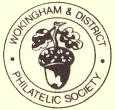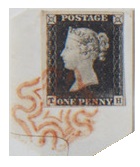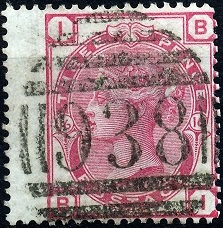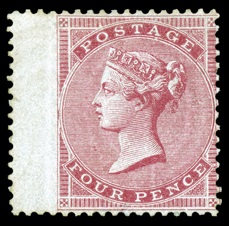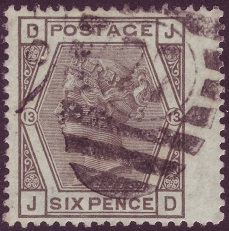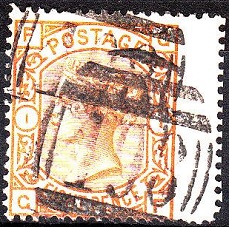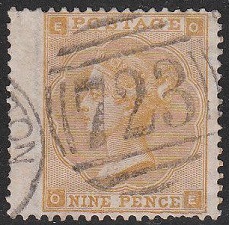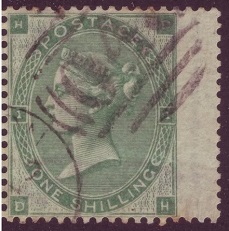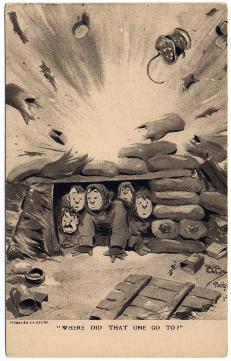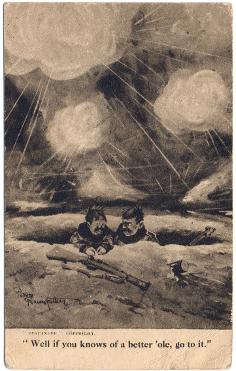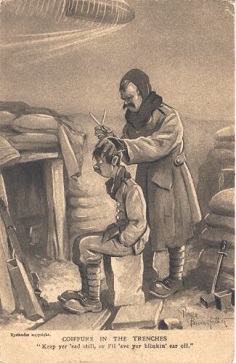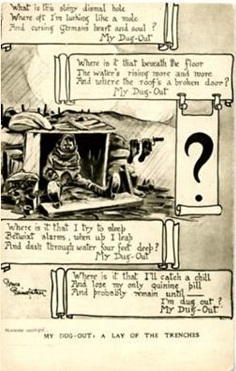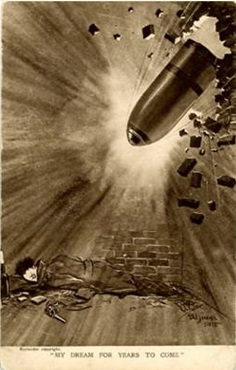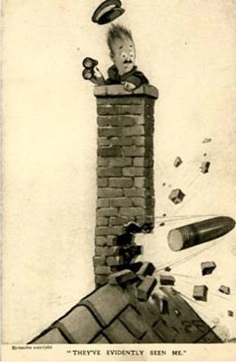11th December 2018 - Christmas Social and Seasonal Displays
There was a good turnout for our December meeting, with, this year, the provision of seasonal food shared among more members. Preceding the eating and merriment, there were displays of seasonal material to help us get in the festive mood.
Christine Earle began, showing a range of attractive New South Wales stationery cards, featuring views of buildings and scenic attractions, issued in 1897 and 1898. These were made seasonal by the messages printed on them "With Christmas Greetings", "With New Year Greetings", and "Greetings From". Christine's display ended with half a dozen scarce cards from The New South Wales Intelligence Bureau and Tourist Council that featured different pictures on each side. There was also topographical information on aspects of the state.
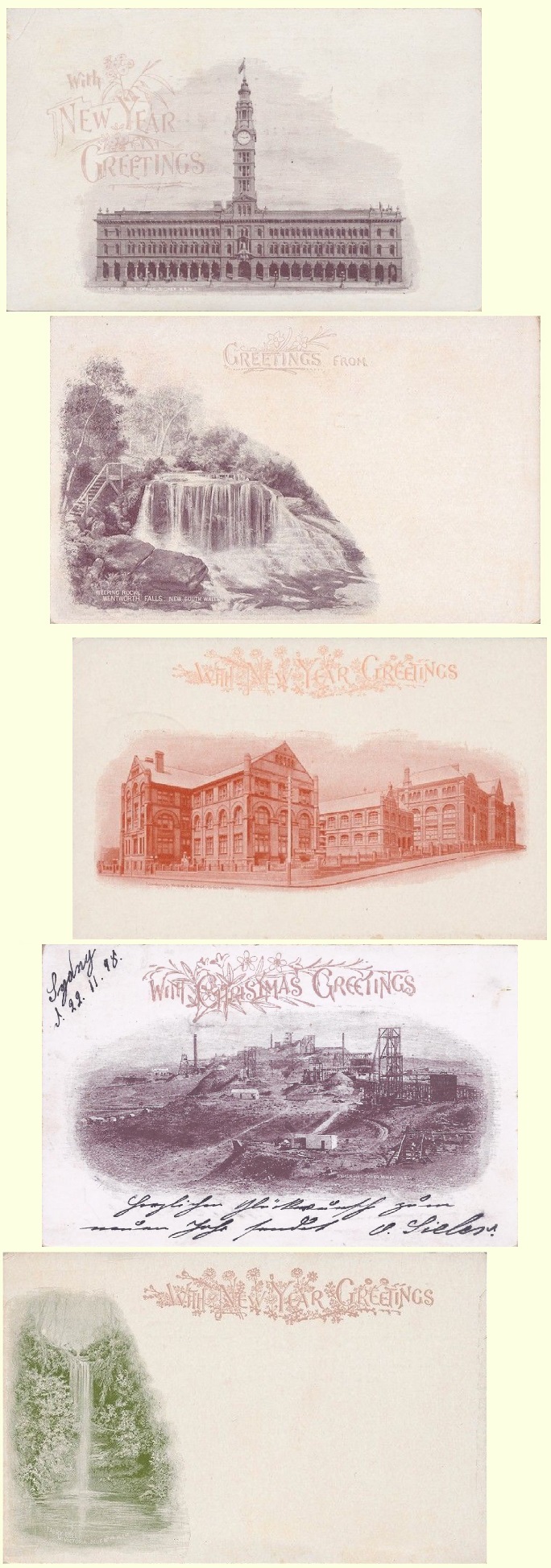
David Gerken departed from his usual bridge theme to bring us Great Britain Christmas-related material, including varieties and Post Office Presentation Packs, and he supplemented this with part of his Working Dogs collection.
Alastair Nixon displayed his reference collection of Christmas labels from 2010 onwards, including slogans (e.g. Post Early for Christmas).
Trevor Cornford brought a wide range of Polar material, with a general theme of "Greetings from the South Pole". He included material ancient and modern, with correspondence from Expeditions as well as Christmas messages for current Antarctic bases.
Michael Curling concluded the displays with Christmas greetings, mostly local to the Wokingham area, on cards, cartes de visite, postcards, etc.
The rest of the meeting was devoted to viewing the material, chatting with friends and consuming the tasty array of food that had been provided.
Chairman Mark Bailey thanked everyone for their displays, and for their contributions to the tasty spread. Special thanks were due to Alwyn Lowe, Marianne Murray and Susan Greenwood who co-ordinated the provisions. Everyone went home in a suitably Christmassy mood.
14th November 2018 - Meeting on the topic of Islands in the Sun
Before the displays, the Hon. Secretary Patrick Reid announced the results of the Thames Valley Federation 16-sheet competitions. Wokingham were first in two classes. Christine Earle won the Traditional Class with "New South Wales Illustrated 1d and 1½d Postal Cards" and Eric Holmes won the Postal History Class with "Spanish Stamps on Gibraltar Mails 1850-1867". Eric's exhibit was also the "Best in Show". As there is no suitable show at which these can be exhibited, the exhibits will be scanned and posted on the Thames Valley Federation's website.
Following the announcements, the members' displays began. Although there is variable sun in Tasmania, Patrick Reid showed a selection of material relating to Tourism in Tasmania.
Chris Rayner showed parts of his Commonwealth collection, with stamps from Antigua, Barbados, Dominica, Jamaica, St Lucia, Trinidad & Tobago, St Kitts Nevis, Mauritius, the Seychelles, Fiji, the Solomon Islands, Tokelau, Papua New Guinea, Ascension, and St Helena.
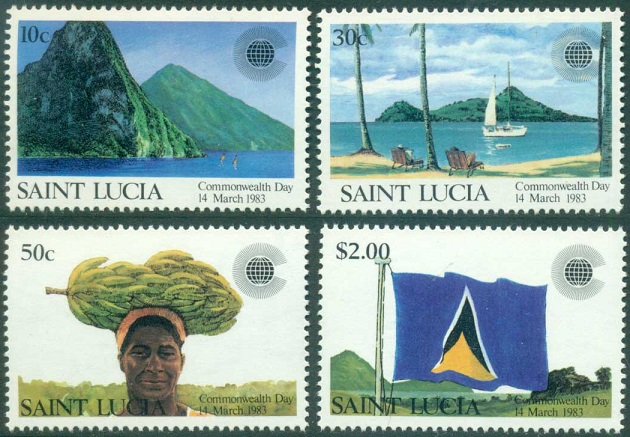
Ivan Dickason followed on, with material from his ½d collection. He included stamps from the Cayman Islands, Ireland, Great Britain, New Zealand, the Pitcairn Islands, and Trinidad & Tobago. Ivan finished his display with 3 sunny places that are not islands: Morocco Agencies, Tangier, and Natal.
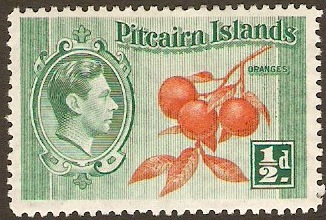
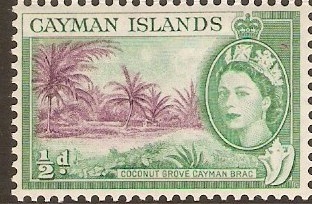
Roger Sammons displayed some unsold lots from the recent Reading auction. These were from Anguilla, British Indian Ocean Territories, Ceylon, Christmas Island, Cyprus, Dominica, Montserrat, Nauru, Turks & Caicos Islands, the Pitcairn Islands, and Zanzibar.
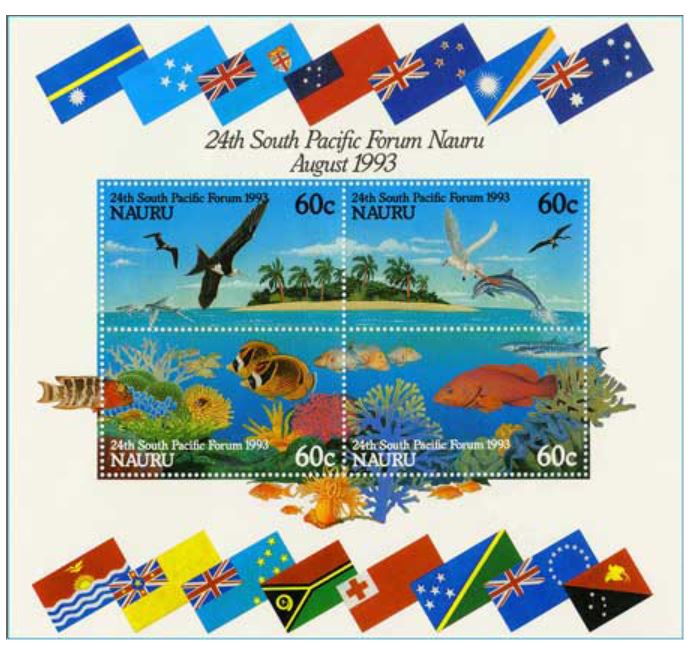
Alwyn Lowe showed Rowland Hill Centenary material from the Bahamas, Barbados, Barbuda, Bermuda, Jamaica, the Cayman Islands, Mauritius, St Lucia, St Vincent and its Grenadines, the Solomon Islands, Trinidad & Tobago, Turks & Caicos Islands, and finally Samoa.
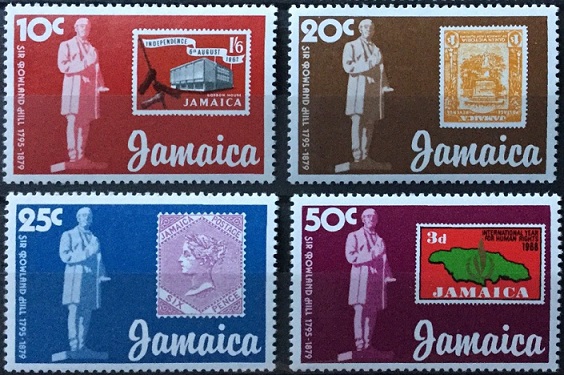
Susan Greenwood displayed orchids on stamps from Cuba, Haiti, Jamaica, Trinidad & Tobago, Dominica, Barbados, Grenada, Antigua, Barbuda, Cayman Islands, and Anguilla.
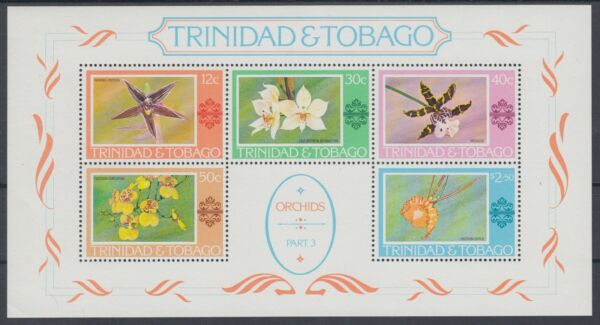
Alastair Nixon closed the first half with a single sheet showing a 1984 Frama label produced as a demonstration for Cuba.
Michael Curling opened the second half with material from a range of islands, though some are not very sunny! He showed Heligoland, Montserrat, Cyprus, Trinidad, Seychelles, Ceylon, New Zealand, Australia (a continent but also a big island), Straits Settlements, and the Cook Islands.
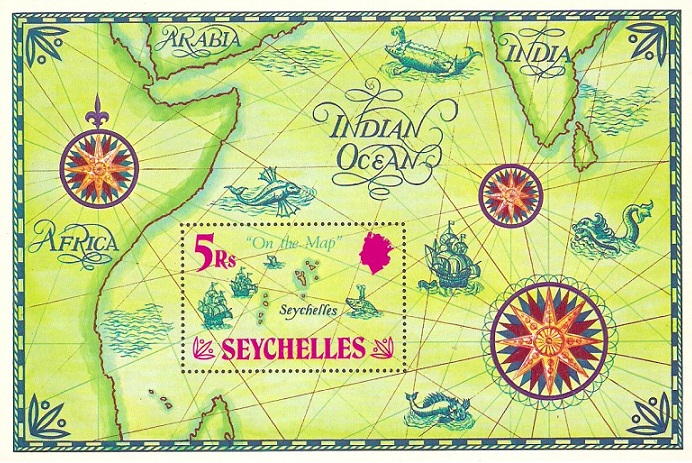
Trevor Cornford followed, with material from "The Federated States of Micronesia" (under United States jurisdiction). The economy is entirely dependent on tourism and diving, and the stamps are definitely "back of the book".
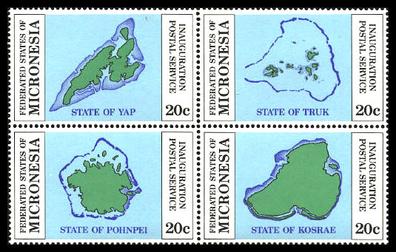
Deputy Chairman Alwyn Lowe thanked all who had brought such a varied selection of material.
23rd October 2018 - Katanga 1960 to 1963 - Gerald Marriner FRPSL
A good audience attended to see Gerald Marriner's presentation on "Katanga 1960-63"
Gerald began with some statistics. The population of Belgium was 11 million, and that of the Belgian Congo 70 million, but Katanga was a mere 5 million. The area of the Belgian Congo is about 950,000 square miles, and that of Katanga 191,000 square miles. On 11th July 1960 Katanga declared independence from Belgian Congo. It is a province with great mineral wealth. Its independence lasted until January 1963.
Gerald's interest in the stamps and postal history of Katanga had been piqued by a stamp from his father's correspondence. He explained that to build up his collection, he sources most of his material from Brussels and Antwerp.
The first frame showed material from the Independent Congo, with its capital Elizabethville, and bordered by Angola, Northern Rhodesia and Nyasaland. This included a letter to Dean Rusk, who was then the US Secretary of State, and memorial stamps for Dag Hammarskjöld, who served as the second Secretary-General of the United Nations.
Katanga had diamond, copper and nickel mines, and when it declared independence in 1960, the resident Belgian nationals were flown out from the Air Force base at Kamina. Refugees were allowed one letter home. Most of these letters were sent post free and stamped in Belgium. For speed these mails were flown in military aircraft. Gerald showed some very scarce cachets, and his display included a letter from the Belgian Air Force commander to his wife.
Katanga first used Belgian stamps, but after two months it used overprinted Congo stamps and Postage Dues with either "Katanga" or "État du Katanga".
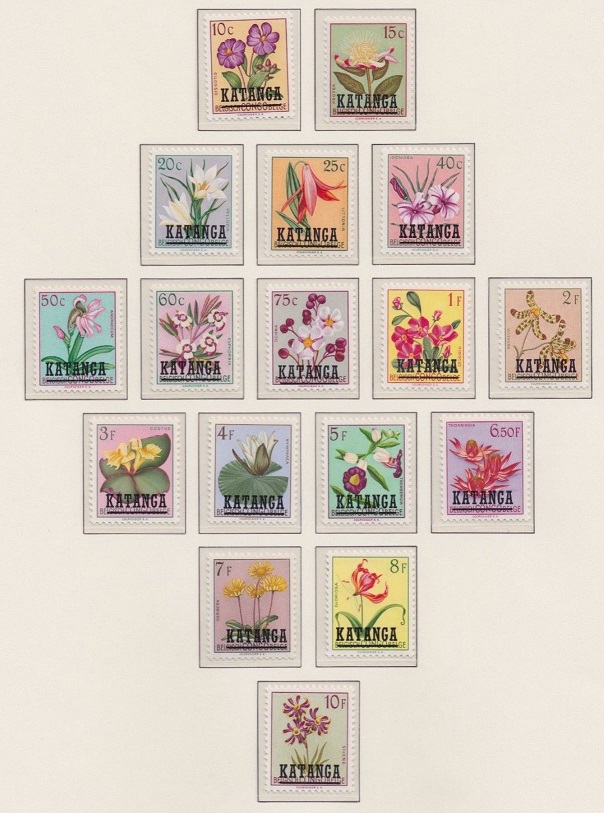
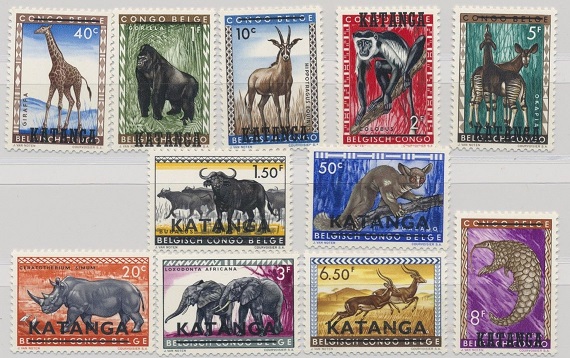
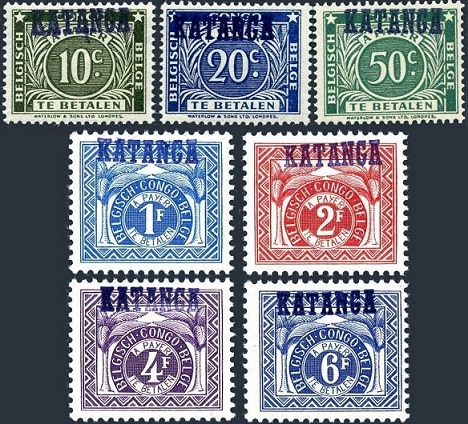
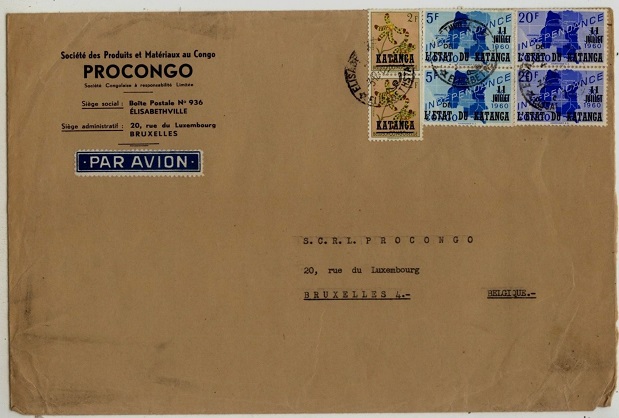
In 1961 Katanga issued its own stamps, with values from 10 cents up to 100 Francs. Postage rates were Belgium 6f50; Rest of Europe 8f; USA 10f; Registration 6f50; Express 8f.
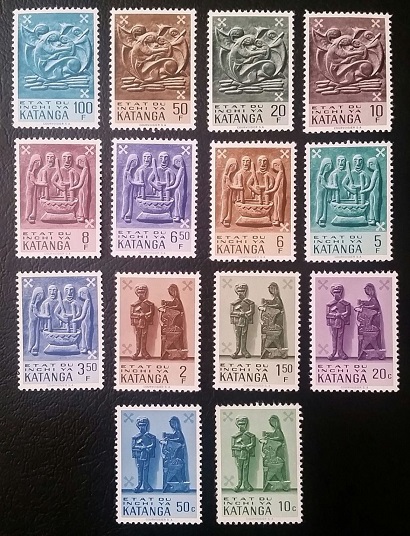
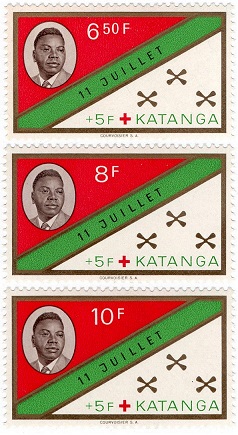
To promote the country, a Trade Fair was held in 1961 and in 1962 the Belgium concession rate was withdrawn. The town rate was 50c, nearby towns 1f50c and the "local" rate was 3f50c.
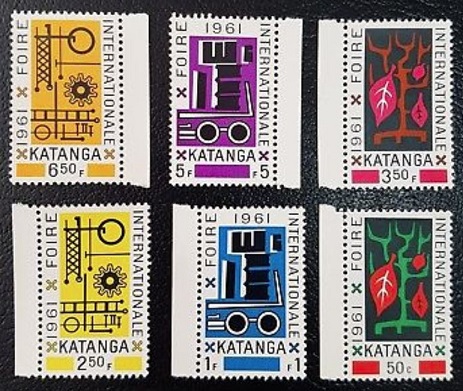
Gerald showed mail to a range of destinations including Egypt, Israel, Switzerland and Hungary and USA. He also showed examples of the 4f postcard rate, 2f concession rate and the 8f rate for postcards to the USA and other rates up to 74f.
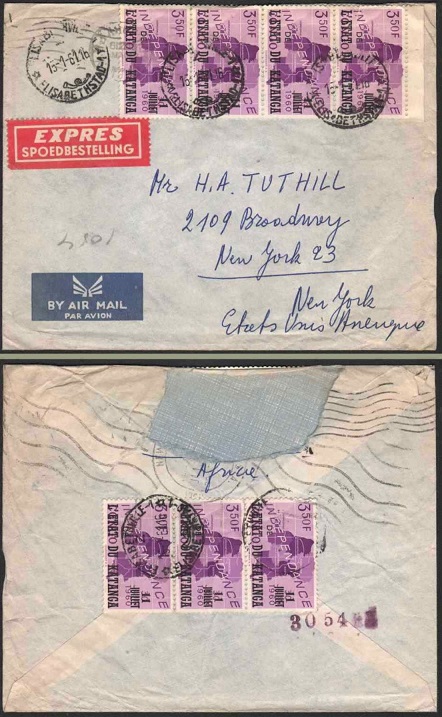
These were followed by a selection of official covers, including one from President Moïse Kapenda Tshombe (the stamp had been removed, but it contained the signed letter), and a selection of invitations to events, including a party at the British Consulate.
Gerald ended the first part with some meter mails, showing the change of country name and mails from Katanga to Congo and some censored mail.
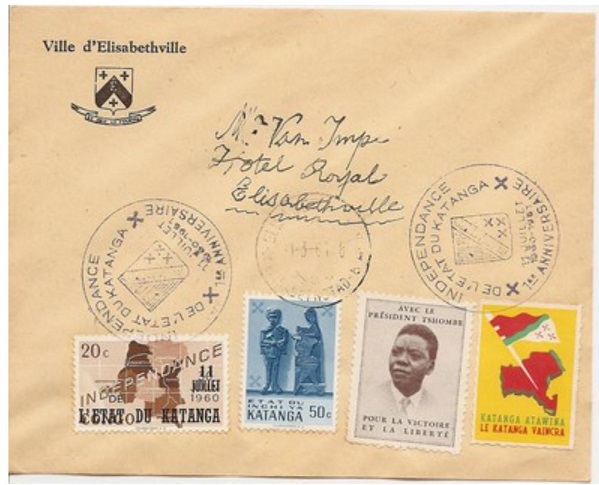
Gerald began the second part of his display with overprinted Postal Stationery, including Air Letters, up to the end of secession on 14th January 1963. Gerald noted that Postal Cards are very hard to find. He showed Belgian Congo cards officially overprinted and uprated, followed by local issues from 1962 rated at 1f50c and 3f. Some examples were the only ones that he has seen.
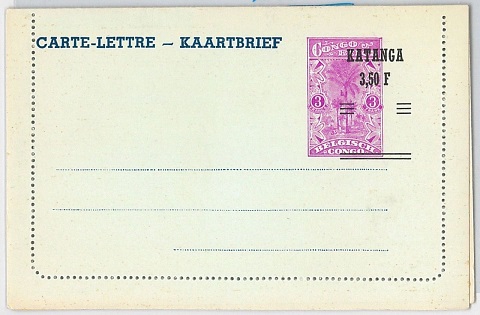
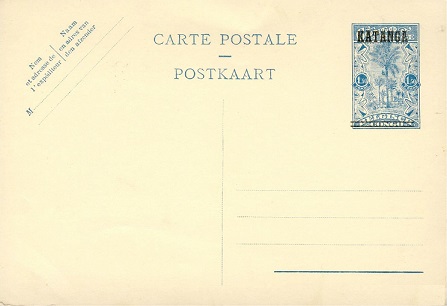
Next came a selection of instructional markings, including a letter from France that was "Returned to Sender", and handstamps for "Postal Relations Suspended" and "Service Suspended", both of which are very scarce.
Gerald showed mail that some companies had sent out via Kitwe in Rhodesia & Nyasaland including mail from a uranium mine that was closed in 2004 and the mine and village destroyed. He also showed mails from Kamina Town to the Air Base and examples of Registration labels from 1960 (manuscript) and November 1960 (handstamped).
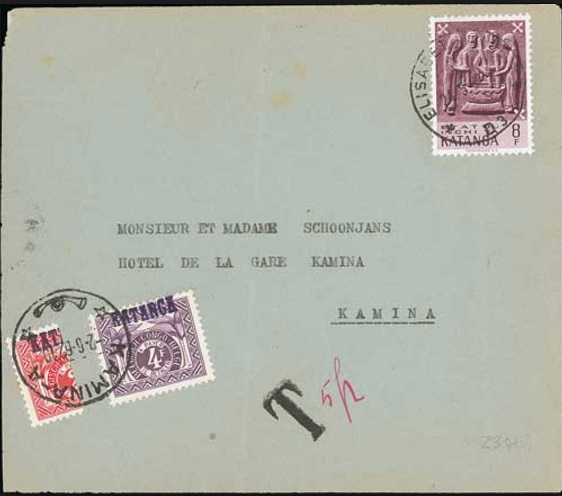
The United Nations (34 countries) took over Kamina Air Base after the Belgian nationals had been evacuated.
The next part of the display was devoted to incoming mail, including underpaid items showing the use of Katanga definitives as Postage Dues. There was mail from Greece, Argentina, Italy and a wide selection of Army (supporting Katanga) mail and Gendarmerie mail.
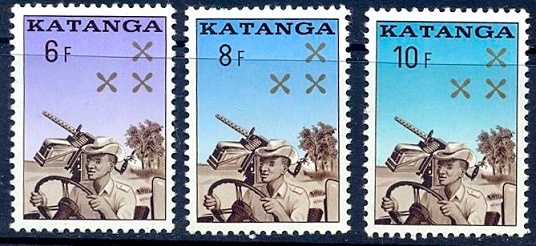
Gerald continued with a selection of mail from Kamina Town, including Registered, and makeshift Registration labels, made by overprinting Elizabethville labels, when they ran out.
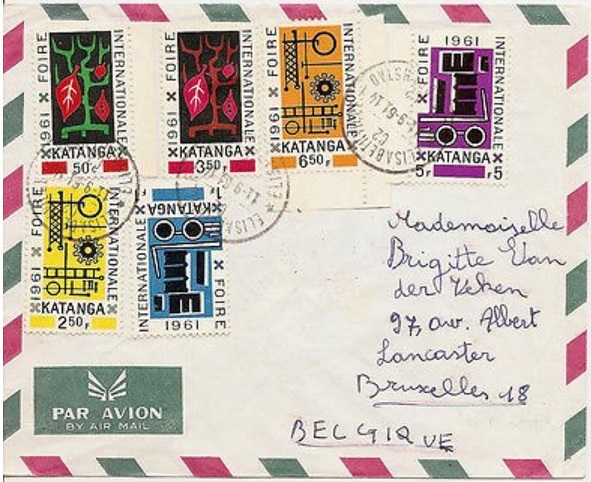
Gerald showed the 1961 International Trade Fair stamps on cover followed by a range of mail from Albertville that had been retaken by the Congolese in 1962 and the stamps were re-overprinted for use there. He showed the re-overprinted stamps, with "Congo" on Katanga issues. The position of "Congo" varies, and the stamps were only in use for 6 weeks. In May 1962 Albertville reverted to Congo stamps.
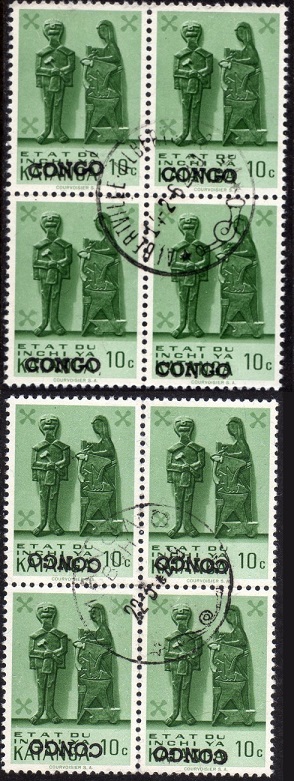
The province of South Kasai, which had mineral wealth, briefly broke away from Congo in 1960, overprinting Congo stamps and then issuing its own stamps in 1961, but it returned to the Congo in 1962. A section on South Kasai included use of Belgian stamps and their own issues from July 1961.
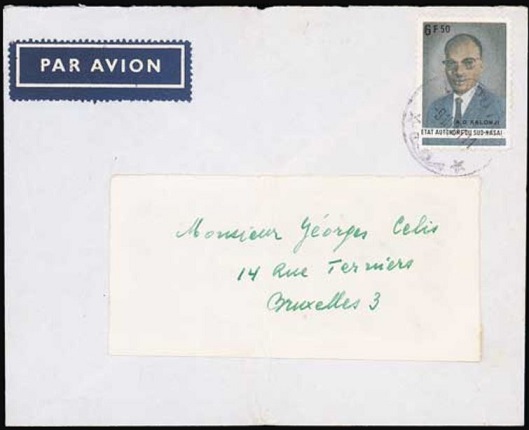
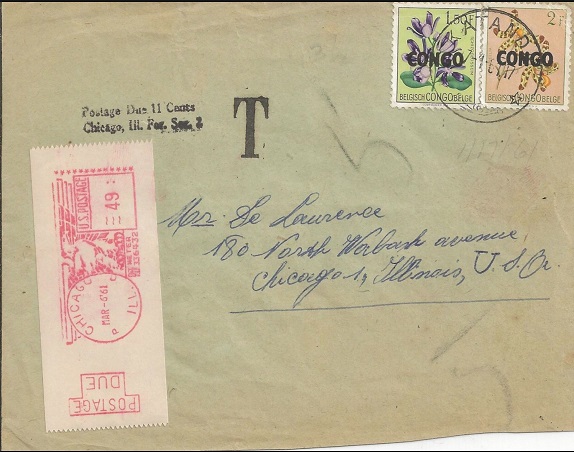
Gerald continued with Belgian military mail, and mail from the Katanga Gendarmerie and letters from a Polish mercenary leader and a French General.
Gerald completed his display with a selection of UN mail. To date he has not found all 30 countries that were present. Unusual items included a letter to Mogadishu via Washington, a cover from an Austrian Hospital to Vienna, and a letter to Brazil. Various other countries were represented, including Canada, Ghana, India, Indonesia and Ireland. The final item was a letter to Dag Hammarskjöld.
Mark Bailey gave the vote of thanks and complimented Gerald on educating us with a fascinating collection of really scarce material.
9th October 2018 - Persia - Nigel Gooch FRPSL
A good turnout of members was entertained by an excellent display of Persia (Iran) presented by Nigel Gooch, a former Treasurer of the Royal Philatelic Society London and the current President of the Royal Tunbridge Wells Philatelic Society.
Nigel explained that this is the only country that he collects, and the first part of his display, covering the period up to 1902, was designed to show the definitive stamps themselves supported by an examination of the various postage rates and usages, both internally and abroad, using wrappers, postcards, envelopes, printed stationery and parcel receipts from the latter part of the 19th century. Nigel was originally introduced to the material when he was a boy, by pulling out discarded envelopes from his father's waste paper basket.
Nigel believes that Persia had the earliest postal system. In 550BC Cyrus the Great, ruler of the vast Persian Empire, ascertained how far a horse could travel in one day and then had a series of posting stations built a day's ride apart. Thus the first postal system was born, with the night messenger relieving the day messenger until the communication was delivered. Nigel quoted as his authority the King James Bible, Book of Esther Chapter 8, Verse 10: "And he wrote in the King Ahasuerus's name and sealed it with the king's ring, and sent letters by posts on horseback and riders on mules, camels and young dromedaries".
In Ezra 4:6 Ahasuerus is mentioned as a king of Persia, and Ahasuerus is a royal Persian name occurring throughout the Old Testament. Ahasuerus appears most prominently in the Book of Esther, and is evidently to be identified with Xerxes I who was the Persian king between 486 and 465 bce, the son and successor of Darius I. In the Book of Esther Chapter 3 Verse 13 it also mentions that letters were sent by posts into all the king's provinces. Chapter 8 Verse 14 states "The couriers rode out in haste on their royal horses, pressed on by the command of the king".
The qiran, also referred to as the qerun or kran, was the currency between 1825 and 1932. It was subdivided into 20 shahi or 1000 dinar and was worth one tenth of a toman. The internal postage rate was 5 shahi, and the overseas rate varied. The earliest item in Nigel's display was an 1830 pre-stamp letter, followed by an item of disinfected mail.
Naser al-Din Shah Qajar (1848-1896) had seen European stamps. The first stamps for Persia were printed in 1869 featuring the symbol of the country, the "Lion of Persia".

The lion design stamps were originally issued in blocks of four, then strips of four before reverting to blocks. The subsequent definitive issues show the Lion on the lower values with the higher values featuring the Shah's portrait.


In 1878 Persia joined the General Postal Union. One issue was stolen, so the next was dipped in saffron to help with the identification of possible thieves.
Persia was one of the first countries to produce multicoloured stamps, printed at great expense in Vienna. In the 1880s there was an issue denominated in Centimes and Francs, but this was soon abandoned and they reverted to Krans and Shahis.
A postmaster who disliked the officially produced stamps decided to design and print his own and sell them. We were shown examples, but their use was soon proscribed. We also saw Postage Due stamps that were printed but never used.
After Naser al-Din Shah Qajar died in 1896, he was succeeded by Mozaffar ad-Din Shah Qajar (1853-1907), and stamps were printed with his portrait.
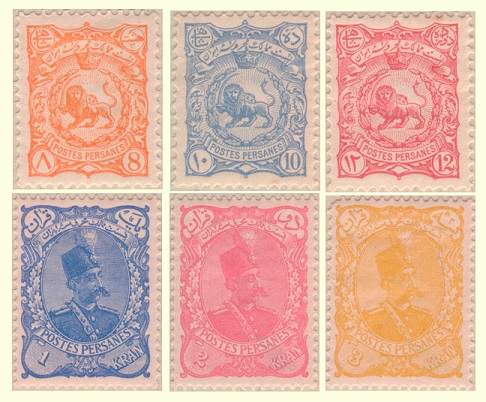
Most large towns had steel cancellers, but smaller towns were allowed to produce their own and most opted for wooden cancellers. This led to some fancy designs of which we were shown examples.
From time to time attempts were made to introduce a prepaid 5 shahi stationery envelope, but it never became popular and was eventually abandoned. There was a Parcel Post service, and some postcards showed the staff sorting the parcels for delivery.
Among unusual letters displayed were an 1896 letter to Surinam, a letter to the USA that was miss sent to Lucerne, and letters to Zanzibar, where there was contact with a Zoroastrian community.
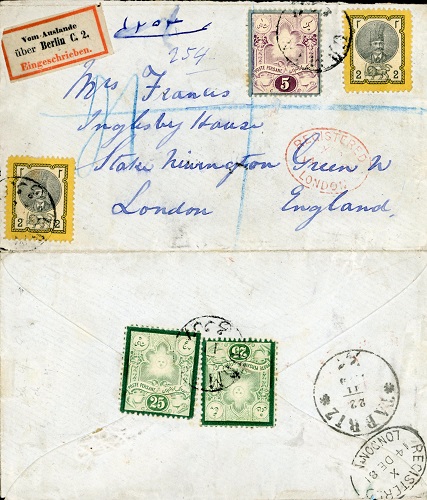
Towards the end of the 19th century the Post Office was privatised, but this only lasted for a year. The existing stamps were overprinted to reflect the change. When the Post Office was re-nationalised, the stamps were reprinted on green paper. Eventually, the Post Office printed their own stamps, which Nigel likened to bus tickets. There are two printings with denominations in upper and lower case respectively.
In 1902 the Belgian Controller of the Post Office in Mesched, Victor Castaigne, found that his regular stamps had run very low, and as no new supplies arrived, he was forced to find substitutes. These provisional Mesched stamps bore his initials V.C. in an oval. Six values were produced - 1, 2, 3, 5 and 12 shahis and 1 kran (the 5 shahis was printed in two colours) - so 7 types in all were printed. From the beginning of March to the end of May about 6,000 stamps were sold, including 600 of the 1 kran. As soon as a fresh supply of regular stamps arrived, the remainder of the provisional stamps were destroyed. The design was drawn by Castaigne, and the engraving was done by Persians on copper. Three engravings were made, one for the frame, one for the figures, and one for the initials V.C. Each stamp received the signature of the director of the post, the 1 kran in violet, the other values in red ink.
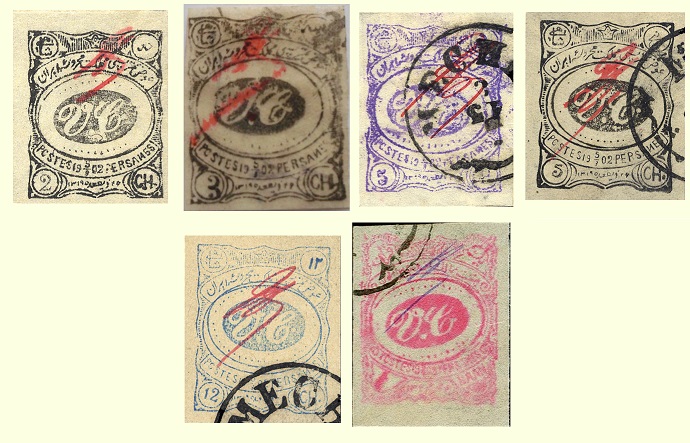
The second half of the evening was devoted to illustrating the many and varied aspects of collecting Iran focussing on Nigel's personal choice of items from the period 1939 to 1982 that he had collected over a period of 50 years. At the beginning of the second part, Nigel recounted some of his personal collecting history. At the age of 13 he won the Junior Sussex Cup with an exhibit of Wildings, but his father persuaded him to collect Iran. He had help from, and learned a great deal from, the late Bernard Lucas FRPSL (1931-2018). Nigel is a member of the Iran Philatelic Study Circle, of which Bernard Lucas was the President.
Besides collecting material from his father's bin, which gave him much commercially used material, Nigel's father further encouraged him by buying an Iran collection. He noted that there are many forgeries and reprints of the issues from 1910 to 1924.
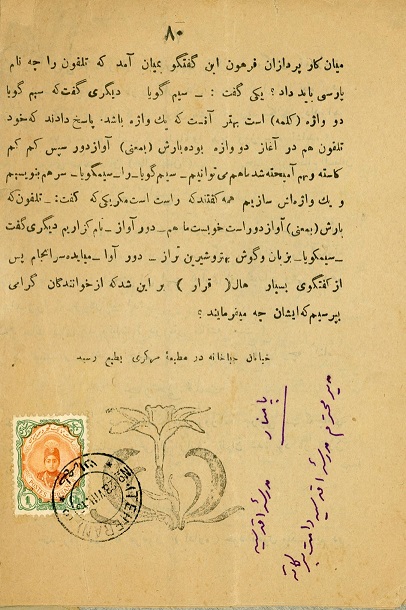
During World War I Persia was neutral, but was the scene of several battles for the oil fields between the British and Russian allies and the Turks. In 1919 an agreement was signed whereby Britain was to exercise controlling influence in Persian affairs, but the Majlis refused to ratify it. Two years later the British began to withdraw their forces from the country. Soon afterward, Reza Shah Pahlavi, commander of an Iranian cossack force, established a new independent government, with himself as minister of war. He became prime minister in 1923 and two years later was elected shah by the Majlis, which had deposed Ahmad Shah, the last of the Qajar dynasty. During his reign the judiciary was modernized, transportation and communication facilities were improved, and a broad program of Westernization was begun.
The rial replaced the kran at par in 1932, divided into one hundred (new) dinars, and in 1935 the name of the country was changed from Persia back to Iran.
Nigel began this part of the display with stamps issued for the first wedding of Shah Mohammad Reza Pahlavi, which took place in 1939.
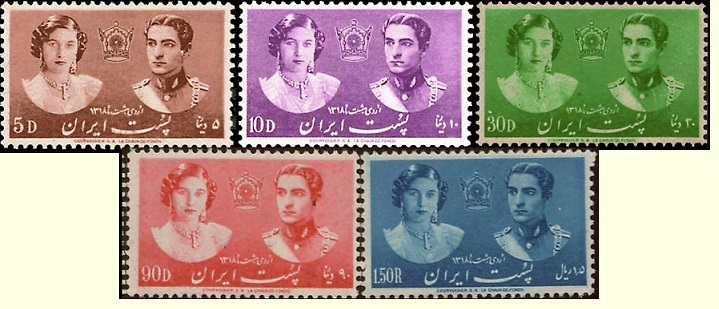
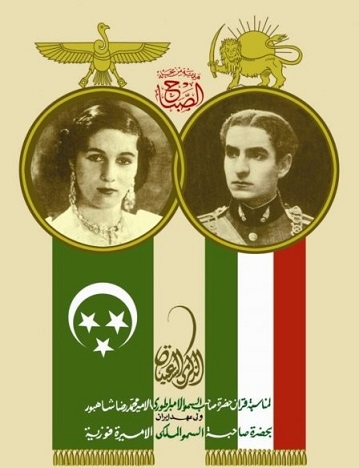
Items shown included a much travelled letter to a Foreign Legionnaire, eventually returned to the sender, commemoratives issued for (to us) odd reasons, and mail to Mauritius and South West Africa. Nigel noted that there are very few single franking covers.
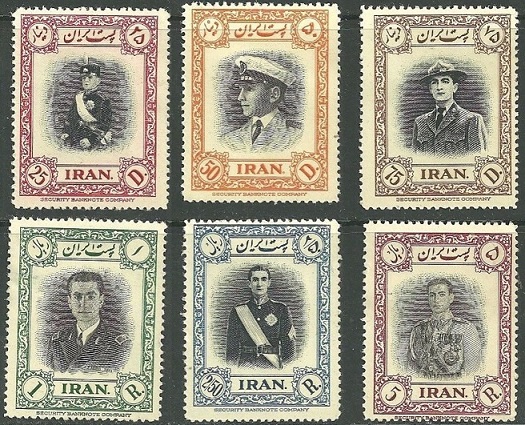
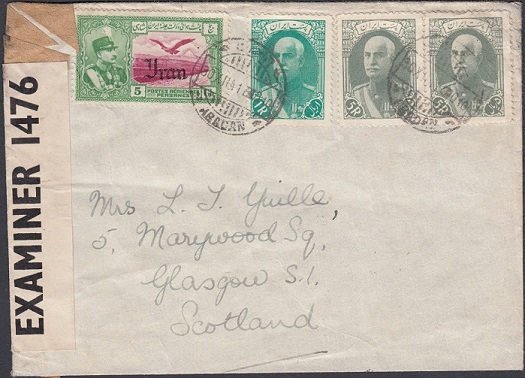
The Shah divorced his first wife in 1948, and next came stamps for the second wedding of the Shah, followed by a set commemorating National Sports, including Archery and Lion Hunting. Shah Mohammad Reza Pahlavi married his second wife Queen Soraya in 1951. However, the imperial couple's marriage had disintegrated by early 1958 owing to Soraya's apparent infertility, for which she had sought treatment in Switzerland and France, and the Shah's suggestion that he take another wife in order to produce an heir. When it was announced that the imperial couple would divorce, it was, the 25-year-old queen said, "a sacrifice of my own happiness". The marriage was officially ended on 6 April 1958.
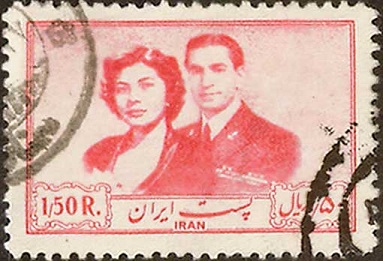
A 50-dinar Red Lion and Sun postal tax stamp, with denomination and inscription only in the Farsi language, was introduced in 1950 to pay a compulsory tax on registered letters. The tax was to support the Iranian Red Cross and Red Crescent, and remained in effect until June 1980 when the clergy gained full control of the government.
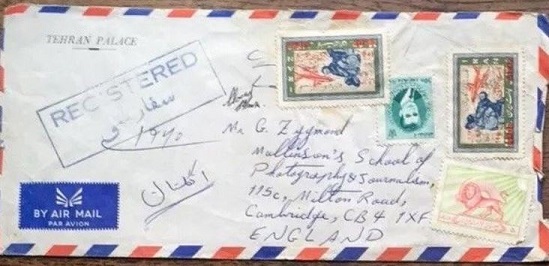
After his first two wives had failed to produce a male heir, the Shah got married a third time and his third wife gave birth to a son.
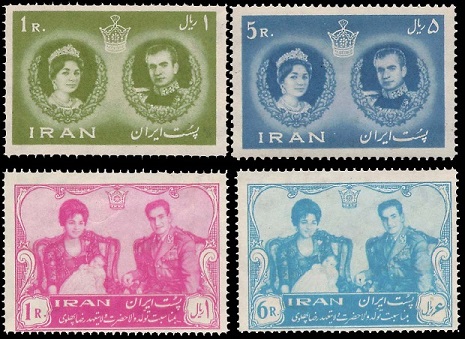
There were stamps produced in 1961 for the Royal Visit of Queen Elizabeth II to Iran.
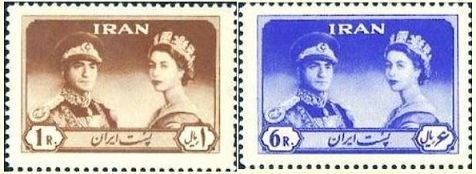
Further material shown included a genuine used copy of the moon landing stamp, stamps for the 35th Anniversary of the Shah's accession and the 1976 stamps marking the 50th Anniversary of the Pahlavi dynasty.
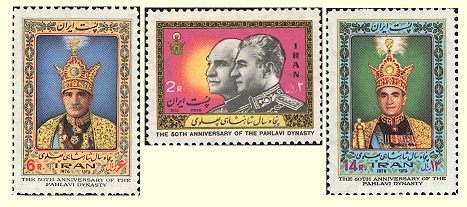
Of special note (to be taken with a pinch of salt) was a cover giving a return address of Osama bin Laden. To close the display, Nigel showed a few "Ayatollah" stamps issued after the Pahlavis had been overthrown in a revolution.
Mark Bailey thanked Nigel for presenting the material in an informal and engaging way. He said that he felt sure that most had not seen such material before and that we were all better educated about Persia.
25th September 2018 - The Number 6
The following members gave displays of up to 10 sheets of material loosely relating to the number 6:
Alan Kane's display consisted of numerous items from Northern Ireland. He had an item of pre-stamp mail with an Armagh 66 mileage mark, and another with a Banbridge 60 mileage mark. Alan also showed stamped items with the stamps cancelled by Belfast 62 numeral cancels, and a selection of envelopes where the date stamps had 6 in the dates. His display included fine examples of the Belfast Spoon cancellations with the number 62. Finally, Alan showed 6 Northern Ireland stamps with the figure 6 in their denominations.
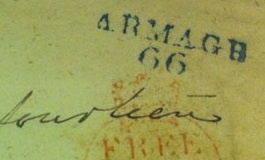
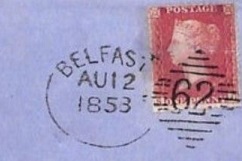
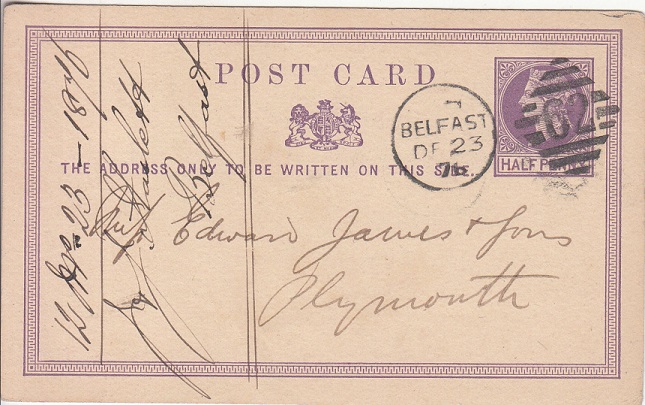
Roger Sammons had brought along a display of Europa stamps from the 1960s.
Alwyn Lowe's display also related to Europa, as it featured the first 6 countries that issued Europa stamps between 1956 and 1961, i.e. France, West Germany, Belgium, the Netherlands, Luxemburg and Italy. In contrast, Alwyn also showed blocks of 6 stamps from Sweden and a set of 6 stamps from Jersey.
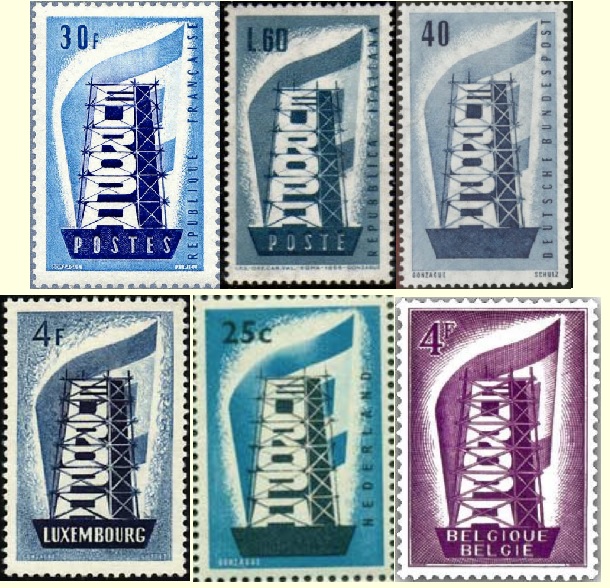
Eric Holmes had brought along examples of the handstruck 6 that was applied to unpaid mail from Gibraltar.
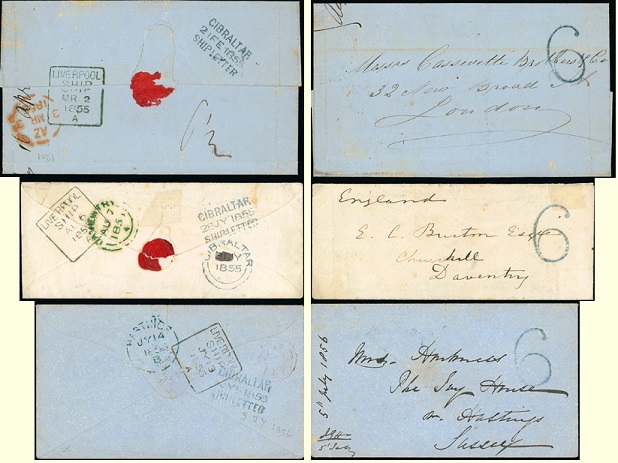
Ivan Dickason showed ½d and 3 pies stamps in blocks of 6 from Pakistan, South West Africa, and Turks and Caicos.
Trevor Cornford displayed a selection of items, beginning with covers bearing Falkland Islands stamps surcharged to raise funds for the SSAFA with +6p and +16p surcharges. He also had an item of Christmas mail uprated from 5p with a 1p, to make the 6p rate. Trevor then showed material relating to Captain Lawrence Edward Grace "Titus" Oates (1880-1912). He was a British army officer, and later an Antarctic explorer, who died during the Terra Nova Expedition. In 1898, Oates was commissioned into the 3rd (Militia) Battalion of the West Yorkshire Regiment. He saw active service during the Second Boer War as a junior officer in the 6th (Inniskilling) Dragoons, having been transferred to that cavalry regiment as a second lieutenant in May 1900.
Trevor completed his display with postcards mailed at the 6c rate from the Queen Victoria to King George V periods, including a card from a Boer War Prisoner-of-War Camp in Ceylon.
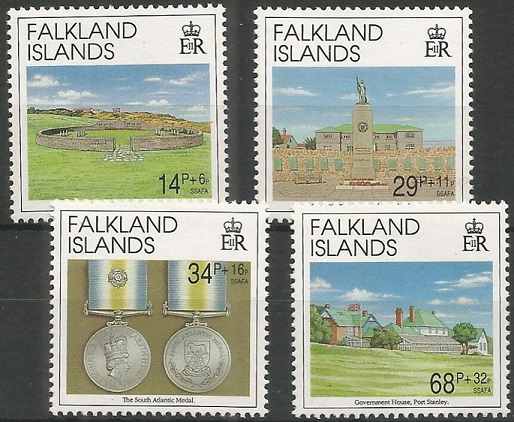
Ron Stone's display related to Massachusetts, the 6th State, and John Quincy Adams (1767-1848), the 6th President of the United States of America.
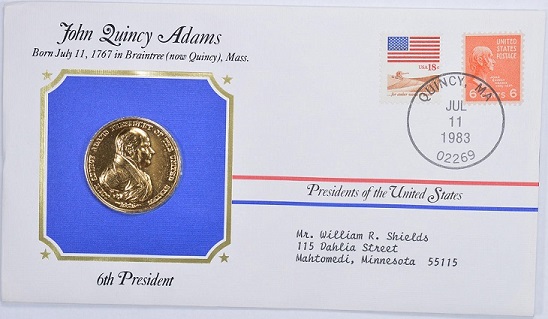
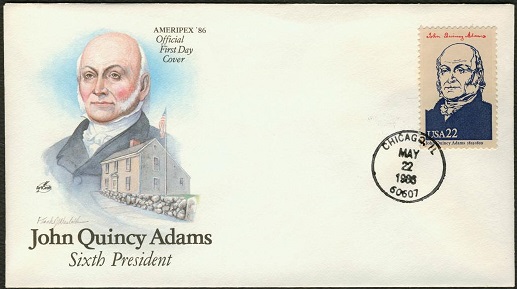
David Gerken showed 10 sheets each with 6 items, including material relating to working dogs and a 6-view lettercard.
Alastair Nixon showed some Horizon labels from Post Office 'Region 6'. In the 1960s, prior to the introduction of the current postcode system, the GPO divided the UK into 10 separate regions for accounting purposes. 'Region 6' was essentially allocated to Wales but the coverage also spilled over into England in places. Each region was further divided into three-digit 'Area codes' and these codes can be found as the last three digits of the office Branch Code (FAD number) found on present-day non-barcoded Horizon labels.
The 10 sheets in Alastair's display showed these labels in both Welsh and English formats for each of the 10 different 'Post Office Areas' within Region 6 (e.g. 'Area 604' covers Anglesey and the Llyn peninsula within the LL postcode area). Each sheet also included a map showing the coverage of these Post Office Areas which can span more than one postcode area. FAD numbers can also be seen on Post Office receipts and an example receipt from Area 642 (that covers the eastern part of the SA, Swansea, postcode area) was shown.
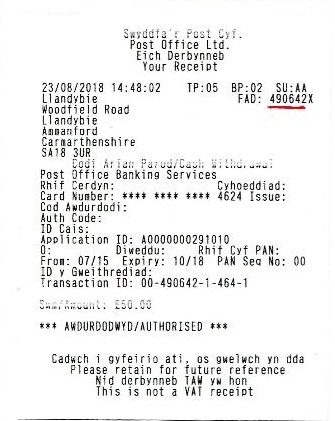
Mark Bailey completed the displays by showing 6 miniature sheets of 6 stamps from Alderney, from 2002 to 2007. The subjects were migrating birds, Arthurian novels and the Just So Stories.
28th August 2018 - The Ladies' Evening
Christine Earle FRPSL, Marianne Murray and Susan Greenwood combined their efforts to present a series of entertaining displays for the members.
The first half was presented by Christine Earle, who used the opportunity to combine her display with a tutorial, following on from the previous meeting, on what is allowed in Social and Open Philately. Her display was based on her gold-medal winning exhibit entitled "They also Served" that illustrates the contribution of women to the UK War Effort in the Second World War.
Christine explained that in a display there are no restrictions, but in an exhibit there must be at least 50% philatelic content. She emphasised the wide range of non-philatelic material that can now be shown, and in her exhibit are newspaper cuttings, armbands, medals, badges, shoulder flashes, government handbills, and advertisements, just to name several examples.
At the outbreak of war, the Post Office lost about 75% of its staff, and these were swiftly replaced by women to maintain services. Christine followed with a summary of the evacuation of children, often reversed fairly quickly, and this was supported by maps.
Christine emphasised that letter contents can be included, unlike in Thematic Philately. She gave a brief description of the Rationing System, and explained the origin of the "Dig for Victory" slogan and advert. The material members were able to study included a fascinating focus on other slogans such as "Careless Talk Costs Lives", wartime employment for women, and a number urging good recycling habits such as "Save Waste Paper Metals Bones Rags".
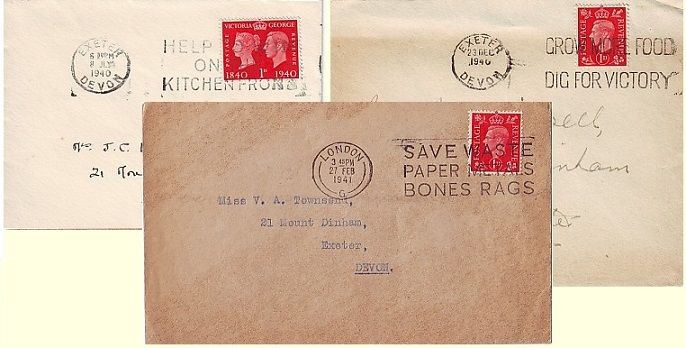
Christine also explained that keeping and breeding rabbits could give extra meat without using ration coupons, and emphasised that clothing and furniture were on ration, with the exception of newly-weds and those who had been bombed out. A campaign to stop ladies smoking was quickly abandoned, as smoking is an appetite suppressant.
Everyone was encouraged to save for the War Effort and a medal was awarded for success. Christine showed interesting insights into savings for the war effort, especially National Savings stamps which could accumulate and be exchanged into War or Defence Bonds or 10-year Savings certificates. Women, in particular, had more money, as a result of their war effort jobs, than they were used to and, there being little to buy in the shops, gave readily to charity or investment. Christine gave a brief description of the Spitfire fund, and explained that the many aluminium pans collected were never used as the cost of making them usable was too high. The Spitfire Fund and other gifts were effusively or more curtly acknowledged by letters. She emphasised that there was propaganda everywhere about aiding the War Effort. Aspects of the "Home Front" were illustrated by stamps, envelopes, letters and ephemera such as posters, ration books (the last being withdrawn in 1953/54), and Empire Propaganda stamps from the Ministry of Information.
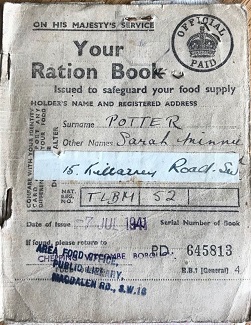
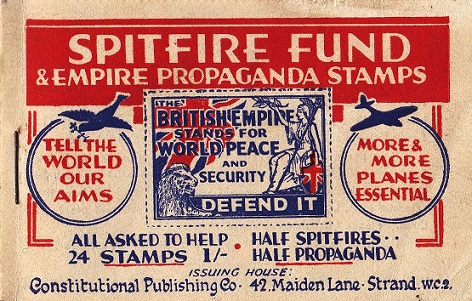
Moving on to women in the forces, Christine explained that the order of preference for most women was WRNS, WRAF, ATS. However, the ATS was given a late boost when Princess Elizabeth signed up. A poster designed by Abram Ganes (1914-1996) for the ATS in 1941 was withdrawn after the MP Thelma Cazalet-Keir led a debate about it in parliament. It was felt that the lipsticked blonde looked too glamorous, and that it looked like "a beauty product advertisement". The concern was that "it is not the sort of poster to encourage mothers to send their girls into the Auxiliary Territorial Service".
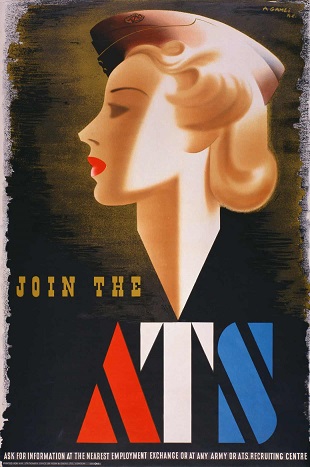
By the end of the war there were over 500,000 women in the forces. The display dealt with the special roles of women in wartime - from support roles in the armed forces, nursing, entertainment and other comforts for the troops, through all sorts of factory "war work", to the WVS, Auxiliary Fire Service, wardens and "civil defence", Bletchley Park decoding, to manning postal services and many other civil activities - all whilst maintaining homes with less male support than previously.
Christine concluded with a section on the end of hostilities, including a newspaper cutting of a VE Day street party featuring her aunt and her mother. The V for Victory with the bells cancellations were issued in 1943, with strict instructions that they should not be used until allowed. Although 8th and 9th May were Bank Holidays, some postmasters used them then rather than on 10th May 1945. The wavy lines in the design incorporated • • • — i.e. the Morse code for the letter V.
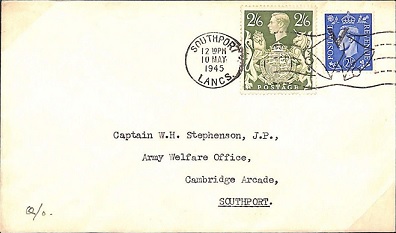
The downside of the end of the war was that the returning men wanted their jobs back, and Christine showed examples of "You're sacked" letters sent to women.
The second half of the evening opened with "Orchids of the British Isles" from Susan Greenwood. She brought along an orchid plant and a vanilla pod, which is an orchid seed. She began collecting in 1982, and her collection is a merger of two passions, stamp collecting and orchids.
Susan explained that orchids can be divided in to house and wild orchids, and there are 66 native species in the UK. She learned at school where to find orchids, and showed a guide to the 40 different orchids that can be found in Berkshire, Buckinghamshire and Oxfordshire.
The first UK philatelic depiction of an orchid was on booklet covers in 1984. The orchid shown was the Noble Dendrobium, Dendrobium nobile, which has become a popular cultivated decorative house plant. In 1991 an orchid was shown in the lower right corner of one of the Greetings stamps.
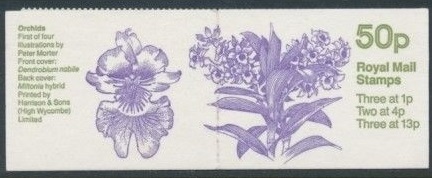
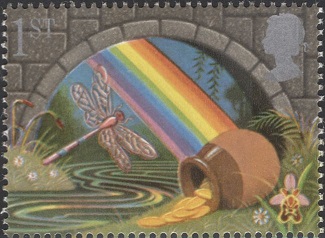
The 14th World Orchid Conference took place in Glasgow between 28 April and 2 May 1993, and the Presentation Pack for the set of stamps issued on 16 March 1993 to mark the event shows which orchids come from where, although no native orchids are featured. Susan also showed a block of four with year omitted.

Moving on from the UK into the other parts of the British Isles, Susan showed orchid stamps from Alderney (showing the Pyramidal Orchid Anacamptis pyramidalis), Ireland, Guernsey, Jersey and the Isle of Man.
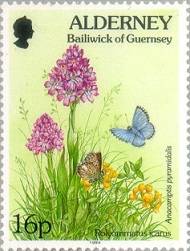
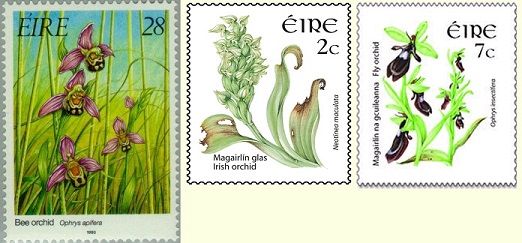
Eric Young in Jersey had built up an orchid collection, but it was lost when the Germans occupied the island during World War 2. However, he returned after the war and successfully rebuilt the collection and promoted orchids. He won nine Gold Medals at Chelsea. His achievements are celebrated on several orchid stamp issues from Jersey, many of which show "hothouse" varieties.
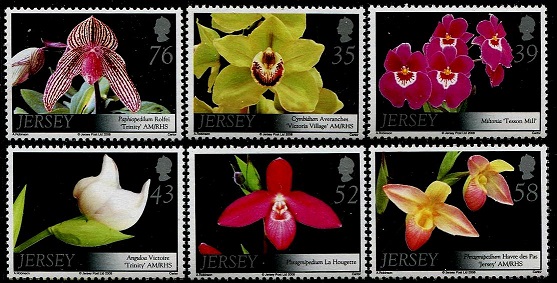

The theme of Marianne Murray's display was her "Holiday Snaps". She limits her collection to GVI pictorial stamps from countries that she has visited on her holidays, and related interesting anecdotes about her experiences in the various countries. She showed material from: Cyprus (2000); Malta (2003); Hong Kong (2009); Alderney (2010); Fiji and Christmas Island (2011); St Lucia, St Vincent and the Leeward Islands (2012); Kenya (2013); (Ceylon/Sri Lanka (2015); Kenya and Zanzibar (2016)..
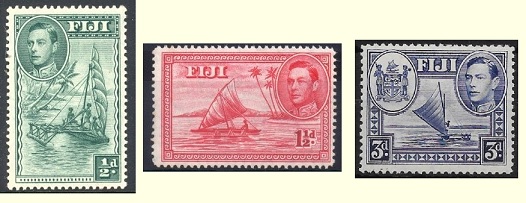
Mark Bailey complimented the ladies on their three well-presented and varied displays, and presented them with decorative brooches and certificates thanking them for their displays.
14th August 2018 - Displaying & Exhibiting Workshop - Patrick Reid FRPSL
Patrick Reid provided the members with an interesting and well-presented workshop on how to prepare sheets of philatelic material for display and also for competitive exhibiting. He illustrated the subject using a slide presentation, and the members appreciated the information and learned some new skills.
24th July 2018 - Annual General Meeting
The Annual General Meeting held on 24th July 2018 was attended by 17 members.
In his report, the Chairman thanked the various members who help run the Society and assist during its meetings. He concluded it had been another good year for the Society, and the 40th Anniversary celebration had been a successful event.
The Honorary Treasurer's report was read and the accounts circulated. The Honorary Secretary made his report, but there was no formal report from the Packet Secretary. The Membership Secretary reported that the membership stood at 70 members.
This is 8 less than the same time in 2017. We had lost several members during the renewal process and one of our Honorary Members died earlier this year. We gained one new Vendor Member during the year. The Committee recommended that the annual subscriptions would remain the same, and this was accepted at the AGM.
As a result of the election of Officers and Committee, Roger Howard stood down from the Committee and Susan Greenwood was elected to the Committee. All the other Officers and Committee members were re-elected.
26th June 2018 - EXPO '58 - Mark Bailey FRPSL
As William Pipe FRPSL was unable to give his display of British Railway Station Cancellations, instead, at short notice, our Chairman Mark Bailey provided a full evening's display related to the World's Fair EXPO '58 in Brussels.
The World's Fair ran from 17th April to 19th October 1958 and attracted over 41 million visitors. The Expo site was constructed over 3 years on the Heysel Plateau. Many countries, including the UK, the USA, the USSR, and most of the European countries, as well as major companies, took part.
The display included poster stamps, postal cards, matchbox labels, and souvenir cards from a chocolate manufacturer as well as stamps and covers.
The first part covered the period leading up to the opening of the World's Fair on 17 April 1958, and the second part showed all the stamps issued whilst the Expo was being held, and afterwards. Stamps were issued by the United Nations and by a wide range of countries, including Belgium, Liechtenstein, Czechoslovakia, Portugal, France, the USSR, Luxembourg, the USA, Nicaragua, Brazil, Hungary, Iran, Tunisia, Morocco, Spain, San Marino, Vatican City, Italy, Romania, Haiti, Panama, Bulgaria and the Dominican Republic. Mark completed his display with items relating to the celebration in 2008 of the 50th anniversary of Expo 58.
8th May 2018 - Malcolm Hoskins & Barney Bardsley from the Thatcham & District Philatelic Society
The Society was treated to an evening of entertainment provided by two visitors from the Thatcham and District Philatelic Society.
Barney Bardsley's display was titled "Penny Blacks and A Bit on the Side". Barney's interest in the Penny Black was sparked by being given one as a leaving present from work. He related the history of the origin of the stamp, and explained that there were 2600 entries in the 1839 competition to find a suitable design. In selecting a design, the Postal Authorities had two concerns: forgery and re-use. The chosen design was based on the Wyon Head, and the background of the stamp was engine-turned to deter forgery.
Barney gave a brief description of the plate production process.
The 1d black was placed on sale to the public on 2nd May 1840, for use on 6th May. It was printed in sheets of 240, and for each of the printing plates, each plate was manufactured from the same master die. This die was engraved and hardened before being pressed 240 times on to a softened plate. This plate was then hardened, cleaned and polished and eventually set to print the stamps. 68 million 1d blacks were printed and released from 12 different plates, numbered 1 to 11, Plate 1 being 2 plates, the softened version Plate 1A and the hardened and longer wearing Plate 1B. The plate numbers were printed in the sheet margin at the bottom left and right corners.
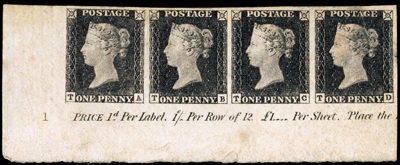
The Penny Black was initially cancelled by a red Maltese Cross cancellation, however this was both difficult to see and easy to remove on a black stamp. After a brief period of using black ink cancellations, at the end of 1840 it was decided to change the colour of the stamps to red brown as the black cancellers used in the later stages of this issue did not show up too clearly on the black stamp. Plate 11 was the first plate produced solely for printing stamps in the new red brown shade, however due to last minute shortages of the black stamp before the red could be issued, it was, for two days only, used as an emergency to supply the late demand. Plate 11 therefore is by far the rarest of all the 1d blacks and is highly sought in any condition.
Barney showed a selection of covers with a range of postmarks, including a turned cover that he was not certain was "right". He then showed examples from Plate 3 (the neat plate), Plate 4 (the spotty plate) and Plates 5 and 6. These included a re-used example on cover where the postmark had been covered by sealing wax.
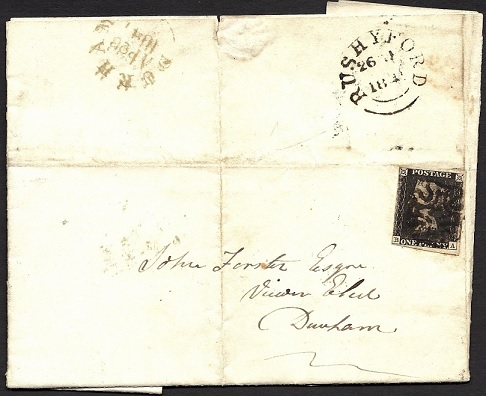
Barney explained the O flaw, where the O in ONE of ONE PENNY has a small white mark extending from the bottom line upwards between the letters O and N that looks much like a Q. The flaw is present on many stamps of Plates 7, 8, 9, and 10 in various stages.

Barney also explained that Penny Red stamps were also printed from Plate 10. A cover showed a last day use of a red Maltese Cross on a Penny Black. He commented that finding black Maltese cross cancels on the early plates is difficult, but, as only 700 sheets of Plate 11 were printed, finding one of those on cover is extremely difficult. He showed an example, but was unsure that the stamp really belonged on the cover.
In the second part of his display, Barney explained what he meant by "A Bit on the Side". He was referring to 'Wing Margins' that occur between 1855 and 1880 as a result of the perforation process. Perforation was carried out at Somerset House.
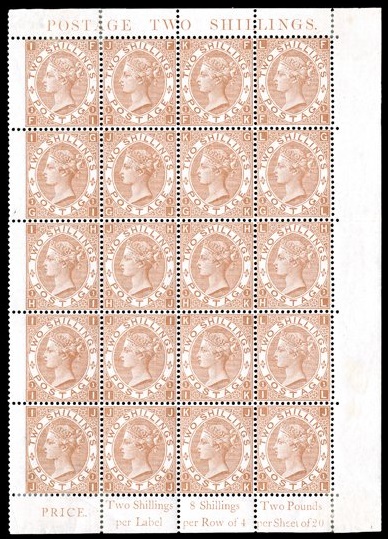
Barney showed examples of the 4d with the three different Garter watermarks, and 6d, 9d and 1/-, all with and without small corner letters. He followed with 3d, various plates of the 6d, 9d, 10d, 1/- and 2/- with large corner letters, and a range of further values, some perforated at Somerset House, and some by De La Rue. He showed some 8d values with imperforate wing margins and closed with a selection of 'mutilated' wing margins, being basically stamps with forged extra perforations.
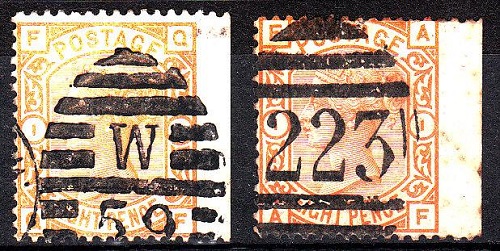
After the break for viewing and refreshments, the second half was presented by Malcolm Hoskins, who showed a splendid selection of postcards by Bruce Bairnsfather, who became known as "The Soldier who made The Empire Laugh". During the First World War, apart from the rum ration and letters from home, there was something else which was said to help maintain morale amongst British front line troops and raise a laugh. It was the character known as "Old Bill". He was the creation of Bruce Bairnsfather, an officer in the Royal Warwickshire Regiment who arrived in France in 1914. "Old Bill" with his blob nose, walrus moustache, muffler and balaclava (later it was replaced by a tin helmet) made Bairnsfather a household name.
Serving as a regular soldier, Bairnsfather left the army in 1907, to pursue a career as an illustrator and had some success producing posters for Beechams and Liptons. When World War One broke out in August 1914, he rejoined the Royal Warwickshire Regiment as a Second Lieutenant and by November was serving at the Front. He started drawing again and before long his sketches were in great demand to decorate dugout walls. Bairnsfather's battalion were in the trenches at Bois de Ploegsteert, a forest near Messines, and it was while resting in billets there that a soldier suggested Bairnsfather send some of his sketches to England for publication.
Bairnsfather's first sketch was accepted by the magazine The Bystander and was reproduced in the issue dated 31st March 1915. Bairnsfather first saw the cartoon in print in May 1915 when a fellow patient at a convalescent hospital pointed it out to him. The drawing showed a group of soldiers peering out of a dugout as a shell exploded behind them. The caption read "Where did that one go to?". Bruce Bairnsfather's cartoons started to appear regularly in The Bystander and realising he was a talented artist, it gave him an exclusive contract.
Perhaps the most famous cartoon by Bruce Bairnsfather appeared in
The Bystander magazine's Christmas number on 24 November 1915, and was an instant hit with its readers both at home and at the front, summing up, as it did, that most elemental of human conditions - discontent. Under the title, 'One of our minor wars', the caption was "Well, if you knows of a better 'ole, go to it". The scenario of two hapless Tommies, marooned in a shell-hole in No Man's Land during a heavy bombardment and bickering over their predicament conjured humour out of the blackest of situations and epitomised both the dry wit of the typical British Tommy with his world-weary wisecracks, not to mention his admirable stoicism.
In February 1916, The Bystander published 43 of his cartoons in magazine form under the title of "Fragments from France." It cost one shilling. Selling over 250,000 copies, it was followed by seven more volumes of his work.
Due to the immense popularity of Bairnsfather's illustrations, they were published as postcards by The Bystander as "Fragments from France". Fifty four of the artist's best cartoons - printed in sepia on soft card - were released in nine series of six cards each; click here for a list of all the cards. Many of them depicted "Old Bill", the "Tommy's favourite wartime character." Malcolm's display showed series 1-6 complete and a selection from the other series. He followed these with a range of WW1 Patriotic cards and other WW1 cards. He also showed some books containing the material he had on display.
Mark Bailey gave the Vote of Thanks and complimented Barney and Malcolm on an interesting and varied evening.
24th April 2018 - The £5 Orange - Dr John Horsey FRPSL
The Society was delighted to welcome Dr John Horsey, author of the definitive book on the subject, to tell us the story of the £5 Orange stamp.
For insurance reasons, there was only one actual £5 Orange stamp on view in the display frames, but that in no way diminished our enjoyment. John structured his presentation to tell the story of his extensive research on the stamp and its development and usage. He explained that his first competitive exhibit, after encouragement from Christine Earle, was a single frame entry at Autumn Stampex 2010. Patrick Reid was on the jury, and encouraged John to develop his exhibit further. It eventually became a five frame Large Gold Medal winning exhibit at Autumn Stampex 2013. This exhibit has been scanned and is available to view on the Stanley Gibbons website.
John decided that study of the stamp needed a few thousand copies, and he collected good quality images for as many examples as he could find, eventually ending up with 3500 unique images for which he recorded the corner letters, and the town, date and type of cancel. His sources of information included the Harmers archive, the British Library, the BPMA, the National Archives, the RPSL Expert Committee, Reading University and the Royal Collection.
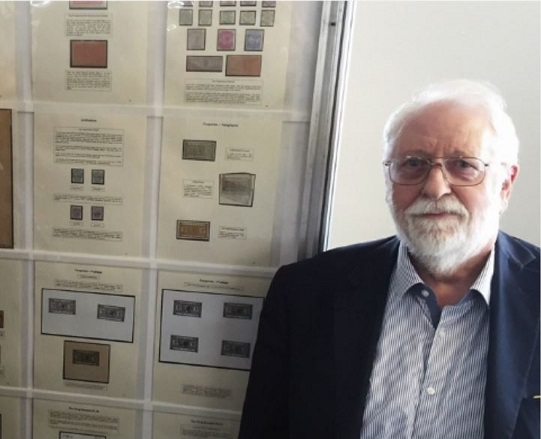
The first half of John's illustrated talk related to the Telegraph stamp, and he explained that the stamp had its origins in the need for Telegraph Stamps after the nationalisation of the Telegraph System in 1870. From 1870 to 1876 normal postage stamps were used, but in 1876 Telegraph stamps valued up to 5/- were issued. However, rates for some overseas telegrams were very high. Telegrams to Bermuda, for example, cost £1, 4 shillings and 4 pence per word (£1.4s.4d). A message of just four words cost more than £5. Even lengthy inland telegrams could cost several pounds to send (one is recorded which was over £32!) and the forms were just not large enough to take all the stamps required. It became clear that values of 10/-, £1 and £5 "Telegraphs" were also needed, and thus the series was added to in 1877. At the time of issue this was equivalent to over a month's wages for a farm labourer.
John showed us three essays and the (almost) final essay that was the basis of the issued stamp, after refinement through 10 progressive die proofs. The fourth essay, the closest to the issued stamp, is in the Royal Philatelic Collection, and John showed it reproduced with the gracious permission of Her Majesty The Queen, to whom copyright belongs. John showed how he was able to determine the order of progression of the die proofs.
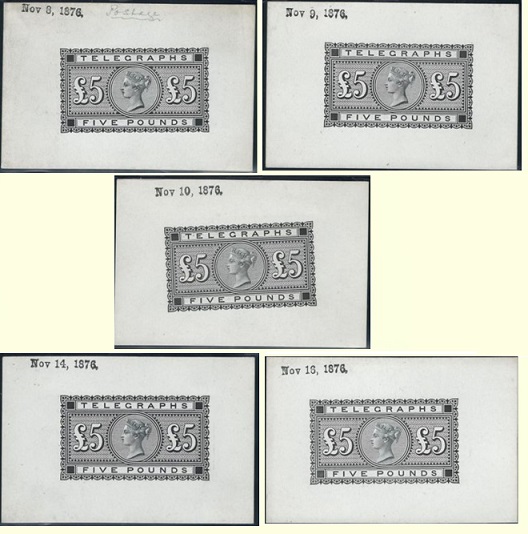
The corner lettering of the stamps differed from that of the regular postage stamps, in that it was sequenced AA/AB going downwards. The corner letters were all hand engraved. The stamp was printed on Shamrock watermark paper. Colour trials were issued in gold and six other colours.
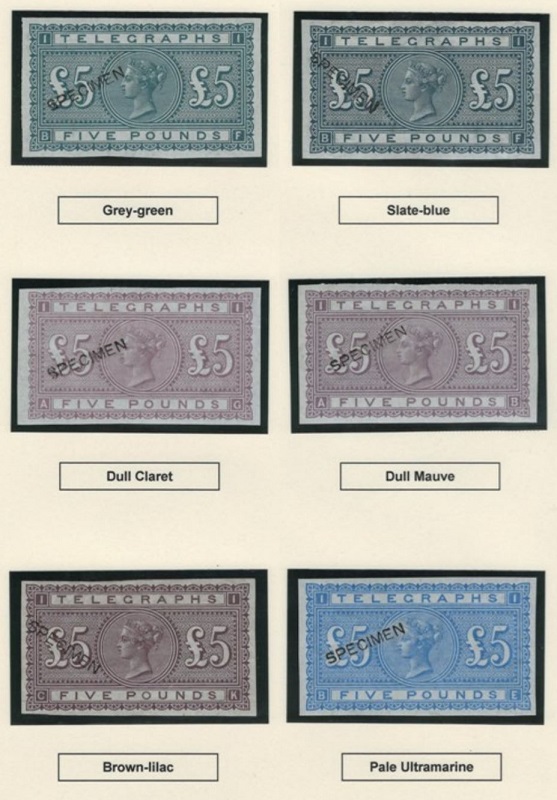
One trial sheet was printed in ultramarine, but, because of potential confusion with the Probate Court stamps, the colour was changed to orange. We were shown a Specimen overprint, that may be forged. The Telegraph £5 was withdrawn in 1881, but later usage is found.
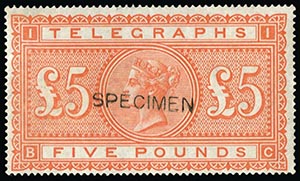
John then gave us an explanation of his £5 Orange Cinderella collection, with items that use the image of the £5 stamp for various promotional purposes, including provision of a £5 voucher.
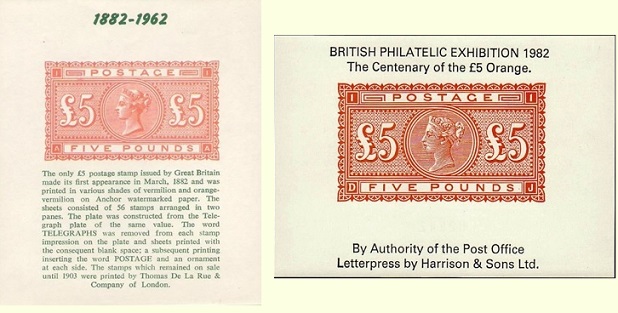
The second part of John's talk dealt with the Postage Stamp.
It was decided that telegraph fees should be paid using postage stamps and all telegraph stamps were withdrawn. As the highest value postage stamp at the time was only £1, a £5 postage stamp was needed for the telegraph service. The word TELEGRAPHS was milled out of the plate and a 28-set plate of POSTAGE was prepared to fill the gap. It is possible that there was a substituted cliché, but there is insufficient evidence to be certain. There is a Black Print sheet in the British Library, and there was at one time a Black and Orange sheet at the National Postal Museum, but that has now disappeared. 28 stamps were removed from the Imprimatur sheet, and 21 are in private hands.
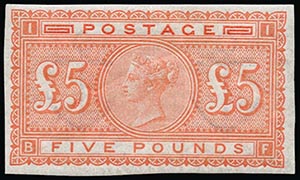
John explained that gutter pairs do not exist. There are stamps referred to as abnormals; these may be identified by the top perforation, and they were perforated at Somerset House.
In 1884 there was a printing on blued paper, and John showed evidence that there is a different SPECIMEN overprint. We were also shown evidence of "double SPECIMEN" on some stamps. There was a total of seven printings, and the Blued/Gently Blued/White papers are difficult to separate, but this may be done by overlaying on the back.
John then turned our attention to usage of the postage stamps. We were shown a picture of a £24/10/- piece, originally used for accounting for postage. Most usage was for high cost telegrams, accounting for bulk telegrams and bulk mail, as well as accounting for Excise Duty.
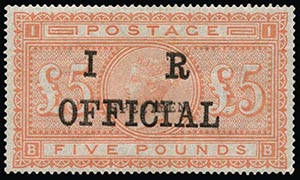
We were shown a range of cancels, but very few are postage cancels. The £5 Postage stamp had a life span of over 20 years, the latest recorded usage being 3 January 1905, but it is believed that at least one London post office still had some in stock up to the 1920s.
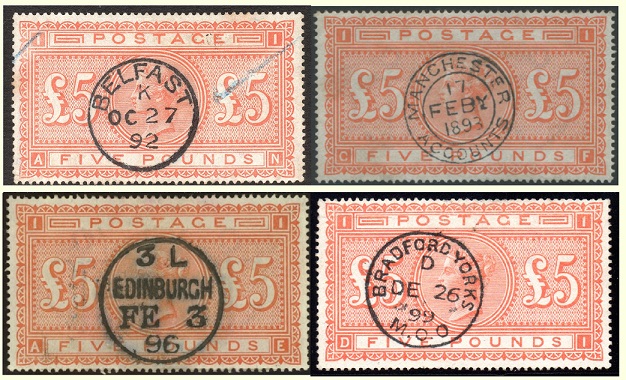
Turning to forgeries, John showed examples of Fiscal cancels bleached out and SPECIMEN stamps used as normal (with a heavy cancel to disguise the word SPECIMEN).
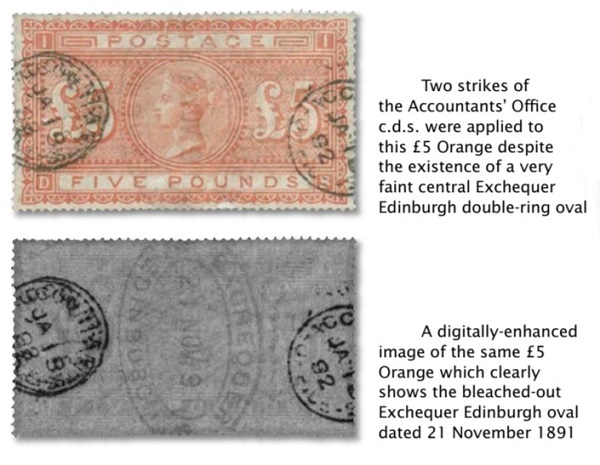
John completed his illustrated talk with images of the Die Proofs of the King Edward VII £5, which was never issued.
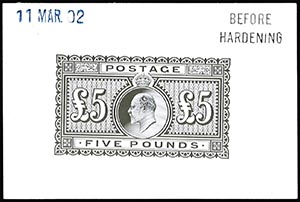
Patrick Reid gave the vote of thanks, and complimented John on his clear exposition of the detailed research he had carried out to enable him to write his book, which is now the reference work on the subject.
10th April 2018 - Informal Competition - Postcards & Cinderella Material
In this year's informal competition, there were 4 entries in the Postcard class and an entry in the Cinderella class. These were judged by the members at the meeting, with the following results:
POSTCARD CLASS
1st equal Alwyn Lowe - "A Small Town in Germany".
1st equal Trevor Cornford - "Postcard Scenes of Africa".
This was a very close competition.
CINDERELLA CLASS
1st Trevor Cornford - "Part of a World of Cinderellas".
The members awarded the best overall award to Alwyn Lowe for his postcard exhibit relating to Schwerin. This is now the capital and second-largest city of the northern German state of Mecklenburg-Vorpommern. It has grown from a small town, and is known for Schwerin Castle that is on an island in Lake Schwerin, and within the old town is the Gothic style Schwerin Cathedral.
Chairman Mark Bailey presented the certificates to Alwyn and Trevor.
27th March 2018 - Labrador Mail Steamers - Brian Stalker FRPSL
Brian Stalker, a retired electrical engineer, was introduced to Canadian Railway Post Office postmarks about 40 years ago and has been collecting, studying and exhibiting them ever since. Apart from building up a significant collection of Newfoundland and Labrador Railway Post Offices (RPO) and Travelling Post Office (TPO) markings, he also takes a keen interest in Canada's Grand Trunk Railway and its constituent companies. Brian is a Fellow of the Canadian Philatelic Society of Great Britain and was inducted into the Order of the Beaver, the Fellowship of the British North America Philatelic Society, in 2015. He is also an active member of several philatelic societies within the United Kingdom.
In his introduction, Brian explained that he collects Canadian National Railways postmarks and related postal history, but he does not deal with the Canadian Pacific Railway. The evening's display would cover Newfoundland and Labrador Travelling Post Office (TPO) markings, and Brian would also explain some of the social and cultural aspects behind the covers.
The area of Labrador is around three times that of Great Britain, and it has 5,000 miles of coastline. In the late 1890s the population was around 2,500, made up of 1,000 Inuit, 1,000 other natives, and 500 settlers. The Inuit were the most literate, partly thanks to the Moravian Missionaries who had transcribed the Inuit language into a High German script. The area described is now part of the Province of Newfoundland and Labrador.
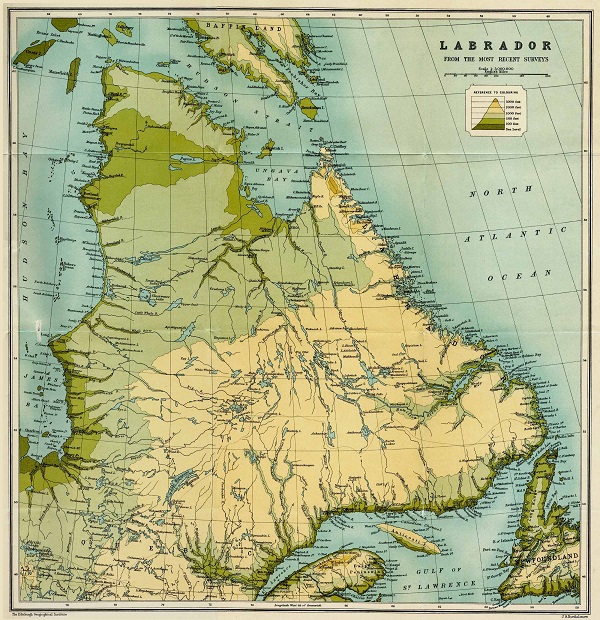
In the first part of his display, Brian covered the Northern mail service up the coast from Battle Harbour northwards. The write-up of his collection includes both Social and Postal history, largely as a result of personal research, as the Newfoundland records were destroyed in 1949.
From 1851, when the Colony took over the operation of the post office, the government let mail contracts for packet boats. The first steam-packet, Lady LeMarchant, operated on Conception Bay after 1852. In 1860 the government decided to subsidize a regularly scheduled steamer service. The subsidized schooners operated on the northeast coast from Greenspond to New Perlican, and along the south coast from Placentia to Channel-Port aux Basques.
The first vessel chartered to the service was the Victoria in 1862. In 1863 Ariel took over, alternating a northern run to Twillingate (later extended to Tilt Cove) with a southern run to La Poile. In 1871 Grieve and Co. replaced Ariel with Leopard and Tiger, inaugurating northern and southern runs based at St. John's, to Battle Harbour in the north and to Halifax in the south.
The steamer services ran from late July to early October only, and provided a connection to the rest of the world. The mail steamer services voyaging from St John's, Newfoundland to Battle Harbour had no on-board mail sorting facilities.
On 20 August 1870 SS Walrus departed St John's for Labrador with Patrick Furlong as Mail Officer. Furlong was probably the purser rather than a Post Office employee, but his detailed report recounted arriving at Battle Harbour at 5pm, 26 August and delivering eight letters. Walrus reached Holton, slightly north of Hamilton Inlet on 1 September before returning to St John's on 16 September with 465 loose, unsorted letters. Further developments during the 1870s saw mail packet services going as far as Aillik, about 450km north-west of Battle Harbour, and as far west as Salmon River in the Strait of Belle Isle, about 350km south-west of Battle Harbour, with five or six trips being undertaken each summer.
After 1877 the two-steamer coastal service continued with Bowring Brothers' Curlew and Plover, while Lady Glover ran in Conception Bay. By 1880, over six trips some 20,000 letters had been carried.
In 1879 Postmaster General Delaney requested that on-board mail officers, instructed by and accountable to him, should be appointed. That resulted in James Campbell, an assistant clerk from St. John's General Post Office, being seconded to SS Hercules in 1880 and placed in charge of the Labrador mails; thus began Newfoundland's Travelling Post Office service. Campbell cancelled and sorted the mail en route; previously it had been taken to St. John's to be sorted.
Each year between July and October, Labrador's population increased five- to six-fold, with the arrival of fishing fleets, some of whom settled in temporary accommodation along the coastline ("stationers") and others who remained at sea throughout the season ("floaters"). The main mail service was for these ships and their shore stations and by the end of 1880 over 30,000 letters had been exchanged between St. John's and the Labrador outports.
The first TPO postmark was introduced in 1882, followed by a "Labrador N(orth)" postmark in 1883. In the 1880s most of the mail was from the Moravian Missionaries. Although the Moravian Mission was based in Germany, it was supplied from London. In 1881, James Campbell was assisted by John McNeil who, by 1884, had taken over as Mail Officer on SS Hercules. McNeil was also allocated an assistant, enabling one officer to attend to shore duties at each port of call while the other remained to conduct on-board postal business. The Labrador TPO was then going as far north as Hopedale on most trips, and to Nain at least once each summer.
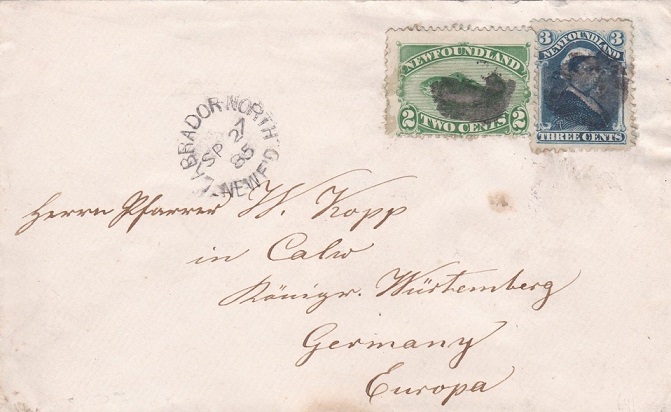
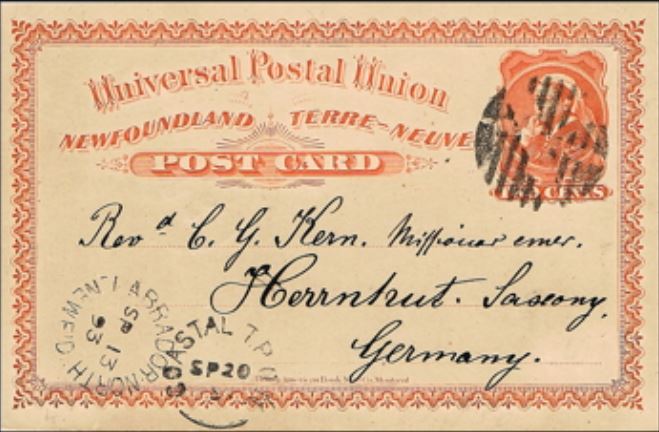
In 1894 a new TPO cancellation with split circles was introduced, and a co-ordinated Railway and Steamer service was operated from 1900. The Postal Officer was expected to know all the people in the settlements and everyone on the ships and where they all were.
The Reid Newfoundland Company first became involved in steamship services with the construction of the ferry Bruce, which began running from Placentia (later Port aux Basques) to North Sydney in 1897. The railway contract of 1898 envisaged a coastal boat and ferry service integrated with the railway, all under the direction of the Reids, in return for an annual subsidy. The Reids anticipated diverting sea-going passengers and freight to the new railway line and operating the coastal service as a monopoly, but it was not to be. On the completion of the railway line in 1898, there was an attempt to consolidate and expand coastal steamship services in Newfoundland and Labrador under the Reid Newfoundland Company, continuing the established practice of subsidized mail and passenger service to the outports. The company supplied six steamers and provided the mail service. They continued for many years right through WW1, during which the Moravians agreed to be neutral (as German Nationals they could have been interned).
In 1923-24, in the aftermath of the Railway Settlement Act, the government took over the service and put it under the direction of the Newfoundland Railway. This was because the Reid Newfoundland Company needed to refurbish the steamers, but the politicians refused to finance this, and in 1923 the ships were handed to the Government for nothing.
During WWII censorship was carried out on board the steamers. After the war a new Royal Mail Ship was added to the fleet and the far North was supplied by a separate vessel. In 1949 Canadian National Railways took over the railway and the coastal boat and ferry operations, under the Terms of Union.
All of the foregoing was illustrated with well-presented and written-up covers that showed and explained the postmarks. Many of these are scarce to rare, with several being the only recorded examples. Most also had salient facts about the sender and/or addressee. The last frame in this part of the display covered 1949 to 1968 when the mail service on the steamers ceased. It included a "last run" cover - philatelic, and believed to be one of 5 or so produced. The steamers still run, but there are no mail services on board, just posting boxes.
After the refreshment break, the second part of the display covered West Labrador, and the servicing of communities in the Strait of Belle Isle. A stunning opener was the only recorded strike of Labrador W(est) on cover. This was followed by a sailor's letter from HMS Rambler. Both English and French navies sent out Fishery Protection Vessels to guard their fishermen during the season.
From 1900 the Reid Newfoundland Company provided a steamer service between June and December. The SS Fife was lost, not on her maiden voyage, but in her maiden season after 5 or 6 trips. In 1903 the service was extended, going from Humbermouth up to Battle Harbour and then down the opposite shore to Notre Dame. This was not considered a success and the service reverted to its original route in 1904. In 1905-1906 the Reid Newfoundland Company was looking for additional business, and this was aided by an interchange agreement with Canada. In 1912, the 1903 service extension was repeated but with two ships, and this was more successful. No mail has yet been found for this route from the 1920s.
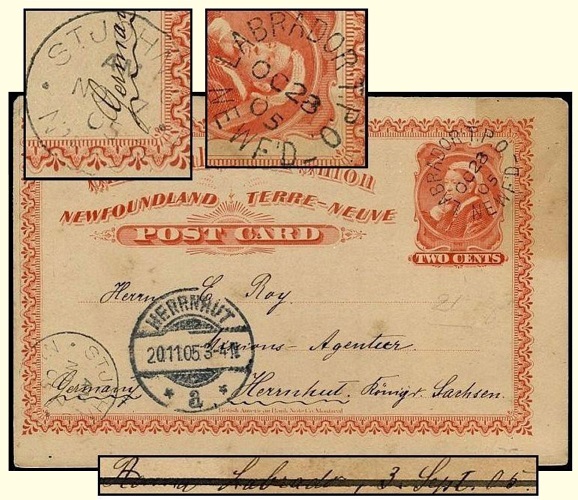
Rear Admiral Robert Edwin Peary Sr. (1856-1920) is best known for claiming to have reached the geographic North Pole with his expedition on 6 April 1909. Peary's claim to have reached the North Pole was widely debated in contemporary newspapers but eventually won widespread acceptance. Brian showed a postcard that claimed Peary had reached the North Pole. A number of special cards were carried on the 1908 voyage of the SS Roosevelt, expedition ship during Peary's final dash to the pole. The expedition wintered in Grants Land in 1908-09 and Peary left from Cape Columbia on 1 March 1909, with a mixed team including six Eskimos, Matt Henson and Captain Bob Bartlett. The party was reduced as supplies became short and on 6 April 1909, Peary made his claim to have reached the pole with a party of four Eskimos and his assistant, Matt Henson. After a stay of only 30 hours they returned to the ship. The special cards were mailed at the first port of call, St. John's, Newfoundland, to mark an event that has been clouded by controversy ever since. In a 1989 book British explorer Wally Herbert concluded that Peary did not reach the pole, although he may have been as close as 60 miles.
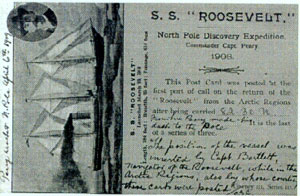
In the mid-1930s Newfoundland was bankrupt, and it was governed from London until 1949. During WWII the postmarks with place names were not used and the old TPO postmarkers were re-used. A new vessel, the SS Northern Ranger was ordered for the service. Any post-war mail is scarce, and there is more philatelic mail than commercial. The service terminated in 1962.
Moving on from steamer mail, in 1889 it was decided to have three mails per winter to Blanc Sablon and L'Anse-au-Loup using dog teams. This was later increased to 6 mails per winter. In around 1908 reindeer from Lapland were introduced to replace dogs for the winter sled deliveries. These could cover 100 miles in a day pulling a sled. We were shown a cover that had missed the last sled and had to wait three months for the steamer, and several others that had experienced delays.
In the 1920s and 1930s some mail was carried by experimental Airmail services, and this became the main means of carriage from the 1950s.
Brian finished with the story of Mail Courier Ernest B. Doane (1867-1945), who he had first come across when researching Newfoundland and Labrador Mail Steamer routes and their mail officers in the National Archives at Kew and later found other references to him in Grenfell Mission-related books. Ernest Doane made treacherous wintertime crossings from Labrador across the 10-mile stretch of the Strait of Belle Isle to Newfoundland. Preparing for the crossing, Doane constructed a very light canvas flatboat, as well as a small, light sled fastened together with skin lashings. Either the boat or the sled could be carried in the other, according to whether he encountered open water or ice. He made around a dozen trips, imperilled by icebergs, deadly currents and ice floes, and once almost floated into the open sea.
|
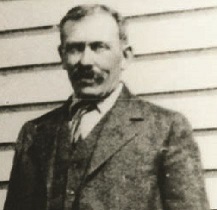
|
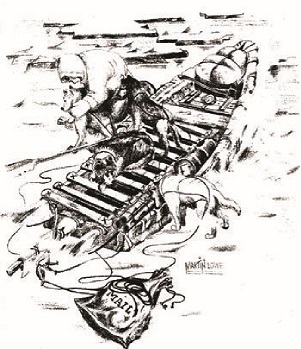
|
|
(above) Mail Courier Ernest B. Doane (1867-1945). Image courtesy of Olive Peiroway.
(right) Doane Prepares for Crossing. Artwork by Martin Lowe, Pinware, Labrador. Image courtesy Labrador Straits Development Corporation.
|
Those who like Birdseye Frozen Food will be pleased to know that Clarence Birdseye learned the fast-freezing technique from the Inuit, who used it to preserve the fish that they caught fishing through holes in the ice.
The Society has, in recent years, been fortunate to have presentations by speakers who are both enthusiastic about their subjects and expert, too - Brian is an outstanding example and the members thoroughly appreciated his display. Mark Bailey thanked Brian for his fascinating and well-presented display, interspersed with anecdotes.
13th March 2018 - Visit by the Henley & District Philatelic Society - Malcolm Gascoyne
Malcolm Gascoyne, representing Henley and District Philatelic Society, entertained us with an extensive display of "Five Centuries of London Mail".
He began with the Elizabethan period, when the post was effectively just for Royalty and the Court. The postmen along the old established routes and on routes temporarily established for some definite purpose were called the ordinary posts and they received a fixed daily wage. If, however, letters should arrive in Dover after the ordinary post had left for London, they were generally sent on at once by a messenger hired for the occasion only. The messenger was called a special post and was paid only for the work which he actually performed. Those regular posts who carried the royal and state letters between London and the place where the Court might be, were called "Court Posts". During the sovereign's tours, posts were always stationed between the monarch and London to carry their and the state's letters backward and forward. These were called extraordinary posts and received regular wages while so employed.
However, the growth of commerce and the increasing importance of merchants meant that they developed their own system of communication by letter. In the fifteenth century many Italian artisans came over to reside in London and elsewhere in England. They were a thrifty people, who did much to place the industrial life of England on a better footing, and many were more intelligent and better educated than the majority of the English artisans. It seems therefore only natural that they should seek to establish a better system of communication between their adopted and native countries. Their business relations with the cloth markets of the continental cities made necessary a better and speedier postal system than was afforded by the Royal Posts.
In the opening year of the sixteenth century, by permission of the state, the foreign merchants in London established a system of posts of their own between London and the Continent, called the "Foreign or Strangers' Post". There was also the "Merchant Adventurer's Post" with foreign-language speakers stationed on the Continent. The service was brought about following the launch of the Company of Merchant Adventurers of London which brought together London's leading overseas merchants. These posts were also used by the English merchants, in spite of considerable dissatisfaction on account of the poor service afforded and on political grounds. They were not treated so well as were their fellow merchants of foreign allegiance. Their letters were often retained for several days at a time, while all others were delivered as soon as they arrived.
|
The "Strangers' Post" seems to have come to an end after the Proclamation was issued in 1591 forbidding any but the Royal Posts from carrying letters to and from foreign countries. The most important collection of merchants' letters to have survived since the late sixteenth and early seventeenth centuries, which was taken overseas and thus was not consumed in the Great Fire of London, is the Corsini Correspondence. The correspondence was sold in London in the 1980s and has been much researched.
The Stranger's Post used couriers between major centres of business and could be sent paid or unpaid. It was often endorsed "Best way possible" in the appropriate language because of the effects of wars and revolts on the safety of routes. Courier letters often bore Guild marks, but the charge marks were only applied to the top letter in a bundle.
|
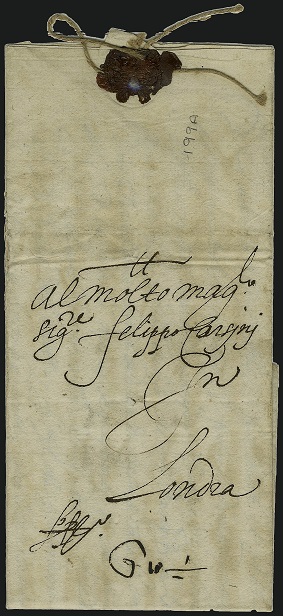
|
|
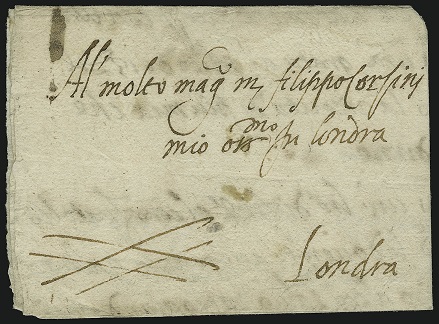
|
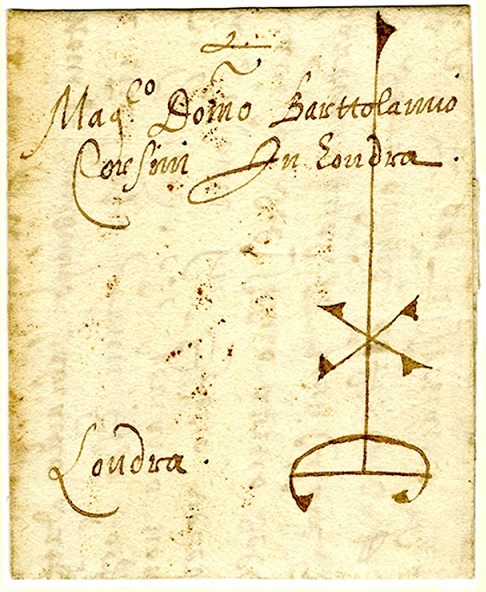
After the Restoration in 1660, the influence of Henry Bishop was seen on the post. Overseas mail was sent paid, part paid or unpaid.
Handstamps from this era are mostly impossible to read, but incoming letters received a Bishop Mark. When refuting charges of delays in the post, Henry Bishop the Postmaster General (June 1660 to April 1663) claimed "A stamp is invented, that is putt upon every letter shewing the day of the moneth that every letter comes to this office, so that no letter Carryer may dare to detayne a letter from post to post; which, before, was usual."
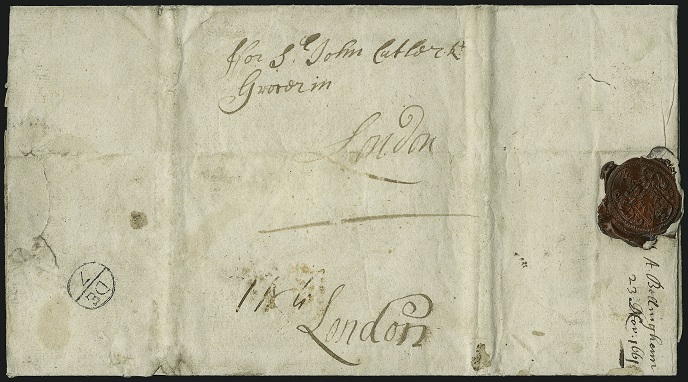
At the close of the seventeenth century there were 49 men employed in the Inland Department of the Post Office in London. Then there were 8 clerks of the roads, who had charge of the mails coming and going on the six great roads to Holyhead, Bristol, Plymouth, Edinburgh, Yarmouth, and Dover. The General Post Office building was in Lombard Street. Letters might be posted there or at the receiving stations at Westminster, Charing Cross, Pall Mall, Covent Garden, and the Inns of Court. From these stations, letters were despatched to the General Office twice on mail nights.
Before 1680 there was no post between one part of London and another, and thus a Londoner having a letter for delivery had either to take it himself or send it by a special messenger.
The houses were not numbered and were generally recognized by the signs they bore or their nearness to some public building. We saw some examples of the distinctive signs. Such was the condition in the metropolis when William Dockwra organized his London Penny Post. In the Penny Post Office as so established on 1 April 1680 there were employed a controller, an accountant, a receiver, 13 clerks
in the six offices, and about a hundred messengers to collect and deliver letters. The six offices were:
- The General Office in Star Court, Cornhill
- St. Paul's Office in Queen's Head Alley, Newgate Street
- Temple Office in Colchester Rents in Chancery Lane
- Westminster Office, St. Martin's Lane
- Southwark Office near St. Mary Overy's Church
- Hermitage Office in Swedeland Court, East Smithfield.
There were in all about 179 places in London where letters might be posted. Shops and coffee houses were used for this purpose in addition to the six offices, and in almost every street a table might be seen at some door or shop window bearing in large letters the sign "Penny Post Letters and Parcels are taken in here." From these places letters were collected every hour and taken to the six main receiving houses. There they were sorted and stamped by the clerks. The same messengers carried them from the receiving houses to the people to whom they were addressed. There were four deliveries a day to most parts of the city, and six or eight to the business centres.
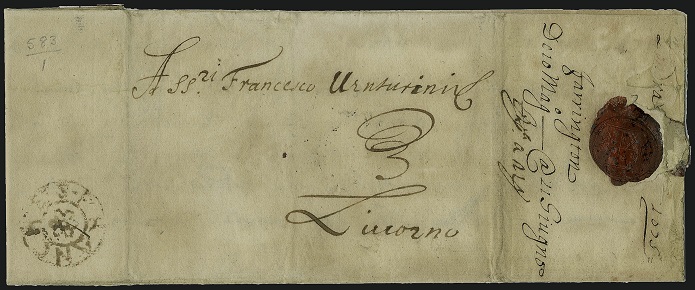
The only marks applied by the clerks were the date (a Bishop Mark) and charge marks. Over time the size of the Bishop Mark increased. In general mail was sent unpaid to ensure that it reached its destination, where the charge would be collected. Malcolm explained that from 1732, circles and random numbers were applied over charge marks. Most mail went to the London Receiving Office. It was noted that the Foreign Office had its own delivery men in London, but only at certain times. We were also shown a typical disinfected mail item.
After about 1730, handstamps that could be read appeared, mail was charged by distance and number of sheets, and inspectors marks were applied if extra sheets were found.
By 1830 there were 148 Receiving Houses in the Town area of London and these Receivers were paid a fixed annual salary of two pounds plus 1d for every ten letters taken in. Lists were issued of these Receiving Houses, which had to be amended as they were constantly changing. There were 6 such lists published from 1794, with the reorganisation of the London Post, to 1 January 1839, when a further change was made. The Town Receivers sent their letters 6 times daily to the Principal Office to which they were attached. Malcolm showed a map of all the 1d and 2d Post Receivers in a small area. General Post Receivers had handstamps that were easy to forge. We saw one of two recorded examples of headed notepaper from the GPO.
The next section was illustrated with postcards of railways. The first "inter-city" service ran from London Euston to Birmingham Curzon Street. The advent of the railway led to the introduction of sorting carriages on trains. Initially there were no markings, but items can be identified from the time taken in transit.
The final frame of the first half showed postcards of various parts of London. These included the Royal Mint, markets, the GPO and several hotels. There was also a postcard of the siege of Sydney Street in January 1911 and some rare cards showing scenes south of the River Thames.
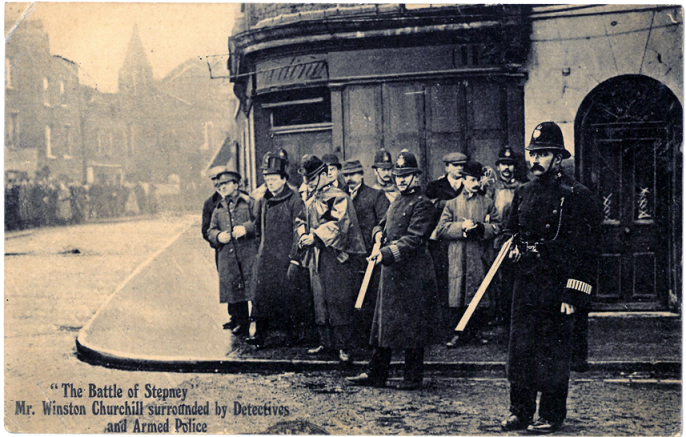
Following the refreshment break, the second half returned to the time of the Restoration. The section covered local posts within London. Originally there were none, but mail could be sent via, for example, a waterman. In 1680 Dockwra, Murray & Chamberlain set up a post (only four examples are known) that was shut down by the government and then swiftly re-opened, using the same people and offices, as the London Penny Post.
Receivers occasionally wrote their name on items, and later handstamps were issued. Mail was transferred from receivers to either the GPO or the Foreign Office. To help pay for the cost of the Napoleonic Wars, this became the London 2d post in the 1800s, otherwise carrying on as before. The service was extended, with the Central area being 2d, and the Outer area 3d, stretching to Croydon, Walthamstow and Hounslow. Later, bye-posts were organised in the Outer area, still at a cost of 3d.
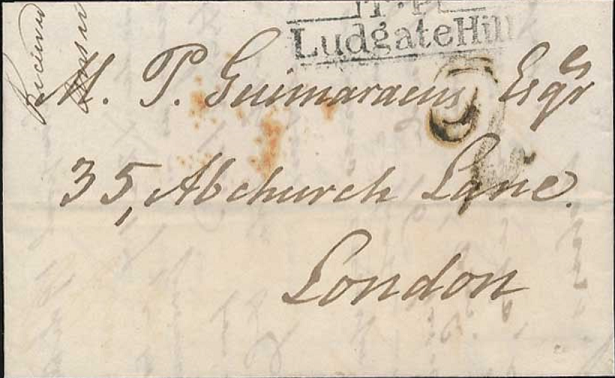
The next section dealt with Coffee Houses. By the late 15th century coffee had become a common beverage in the Near East, but the Ottoman Turks had mastered the art of it. Coffee shops were opened all around Constantinople, and functioned as the center of people's gatherings, political debates, discussions, and critical thoughts. All around were cups of coffee. It became so deeply incorporated into the Turkish culture that a law was created that gave any woman the freedom to divorce her husband if he didn't provide her with the necessary amount of coffee. As the Ottoman Empire expanded, so Coffee Houses were built. The first recorded encounter by an Englishman (in Turkey) was around 1600. It was not until 1615 that Europe was formally introduced to coffee. Venetian traders, who had strong trade links with the Levant, started to import coffee into Italy. Once in Europe, the consumption of coffee soon spread.
The first person recorded in history to brew coffee in England was Nathaniel Conopios from Crete, who was studying at Balliol College, Oxford. This happened in May 1637, and was recorded by both scholar John Evelyn and historian Anthony Wood. Although shortly afterwards Conopios was expelled from college, his influence had a lasting effect on Oxford, as it was in Oxford that the first English coffee house was opened in 1650 by Jacob, a Lebanese Jew. Even though Jacob moved to London a few years later to repeat his success, he had begun a trend that saw many more coffee houses open in Oxford during that decade.
The earliest London Coffee House (or rather, coffee stall) was
opened by a Greek named Pasqua Roseé in 1652 in Cornhill. While a servant for a British Levant merchant in Smyrna, Turkey, Roseé developed a taste for the exotic Turkish drink and decided to import it to London. Coffee Houses prospered and became the centres for various groups, notably merchants, brokers, insurers, slave owners and lawyers. The coffee houses of London were a place of business, a place where business meetings would take place and where many businessmen would establish themselves as regulars, making particular coffee houses the place where people could expect to find them. For this reason many of the London coffee houses were an ideal place for the letters of the penny post to be sent to and collected from. In the New England Coffee House, a tip to the waiter ensured that the mail item went into the bag for the USA. Most coffee houses operated this type of system, and many evolved into hotels. There was a Coffee House in both the Fleet Prison and the Debtors Prison. Some examples of Coffee House mail were shown. Malcolm also noted that in the late 1700s and early 1800s many tokens were issued because of a shortage of small change.
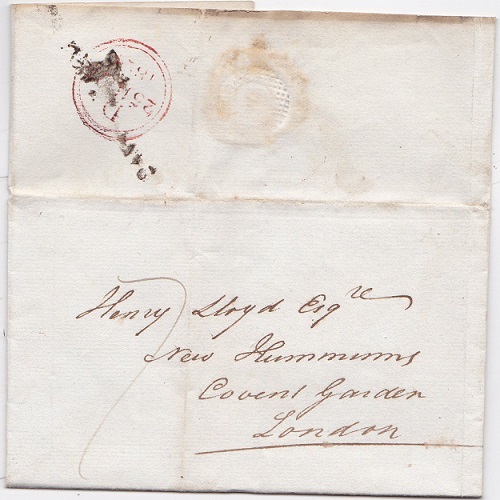
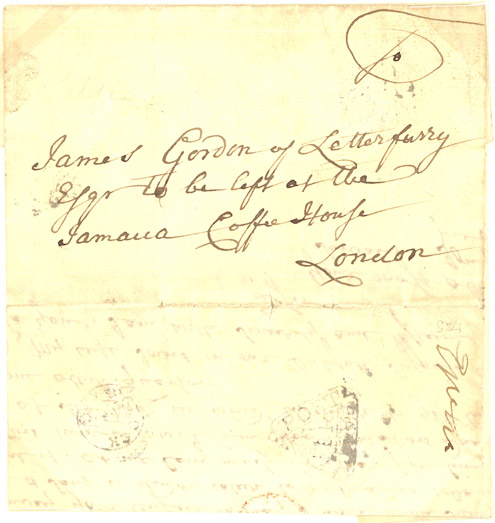
The next section covered London Cancellations. It began with Maltese Cross mail, numbered 1-12, followed by duplex marks, introduced because it required less operations to cancel a cover. As an experienced clerk could cancel about 200 covers per minute, the challenge for machines was to go faster. The options available were limited because the Post Office would not go to the expense of installing steam powered equipment.
Between 1857 and 1912, the London General Post Office tested and/or evaluated no less than 18 machines, most of which were of non-British manufacture and origin. In January 1858, Charles Rideout, a retired post office surveyor, offered the London Post Office a new postmarking machine, which had been patented in October 1857, by his son-in-law, George Beard. Two machines would be tested by the post office between 1858 and 1859. Rideout's machines were of a compact design, could be placed on a table and could effectively apply receival marks to incoming mail at a rate of 160 strikes/minute and duplex marks to outgoing mail at about 85 strikes/minute.
In 1865, two German inventors, Carl Fischer and J.C.W. Maas, applied in England for a patent on their new postmarking machine. Although initially unsuccessful, a patent was eventually issued in August 1867. Another German, Robert Hinrichsen, became the owner and manufacturer of the 'Fischer-Maas' invention. Hinrichsen's sales representative in Britain was J.C. Azemar, who was the contact person with the General Post Office in efforts to have them test and buy Hinrichsen's rapid postmarking machine. The 'Hinrichsen', or 'Azemar', machine was unique at the time since it had 'three' postmarking die heads, with mail being transported through the postmarking zone by a set of two or three needles. With each rotation of the stamping head, three postmarks could be applied to three individual pieces of mail, which offered a significant advantage and improvement compared with Charles Rideout's machines. We saw examples of Rideout and Azemar cancellers.
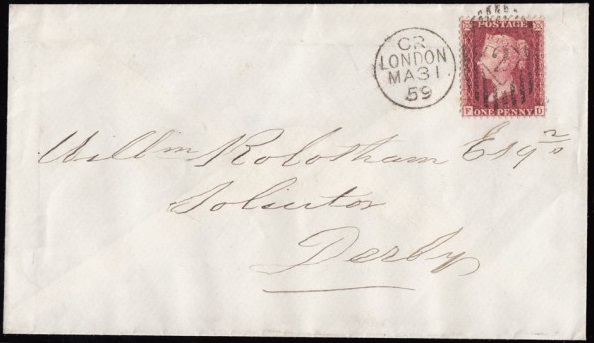
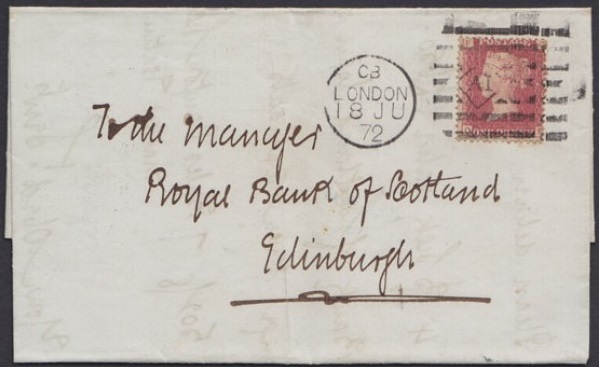
Malcolm ended with a selection of other cancellers, including double rings, some examples of Postage Due markings and finally a selection of Paquebot marks.
Mark Bailey thanked Malcolm for kindly filling in for the two originally expected members of the Henley & District Philatelic Society, and complimented him on the breadth and depth of his display.
27th February 2018 - The Apollo Programme - Barry Feltham
Those members who had braved the weather were treated to an eclectic and enthralling display from our visitor, Barry Feltham. Using up-to-date presentation technology, including videos, audio, scans, etc. all embedded into a Microsoft PowerPoint presentation and accompanied by some 180 sheets of outstanding philatelic material in the display frames, Barry delighted us with the, perhaps now half forgotten, story of the United States of America's quest to land a man on the moon during the 1960s.
Once everybody was seated and the meeting's preliminary business dealt with, the show began ...
Through the medium of an old newsreel video, the presentation began with President John F. Kennedy's speech proposing, in an address to Congress on 25 May 1961, his goal of "landing a man on the Moon and returning him safely to the Earth" by the end of the 1960s. At the time this was a preposterous statement, as none of the technical details had been thought of, let alone tested!
But ... the race was on!

Named Apollo, the programme ran from 1961 to 1972, and was supported by the two-man Gemini programme which ran concurrently with it from 1962 to 1966. Gemini missions developed some of the space travel techniques that were necessary for the success of the Apollo missions, and Apollo used the huge Saturn V rocket as a launch vehicle. Through dramatic, and sometimes quite poignant, footage and commentary we were transported through 10 space missions, including the tragic 1967 Apollo 1 fire that killed the entire crew during a pre-launch test.
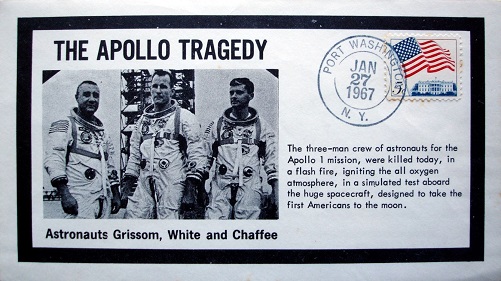
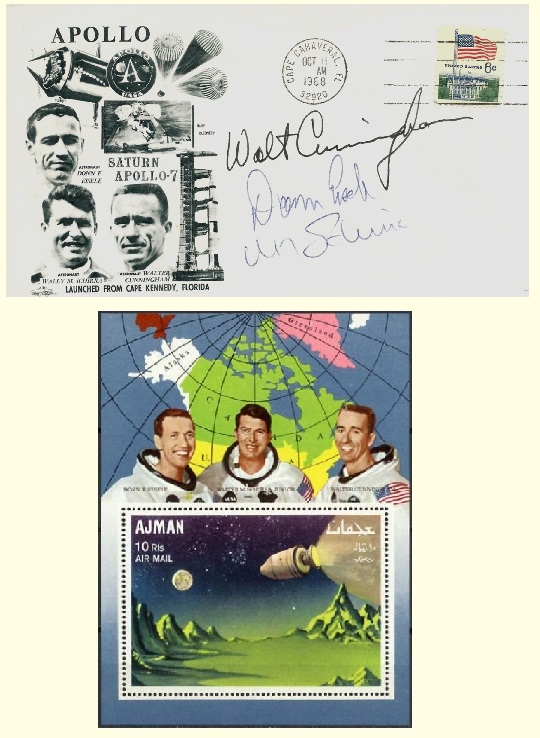
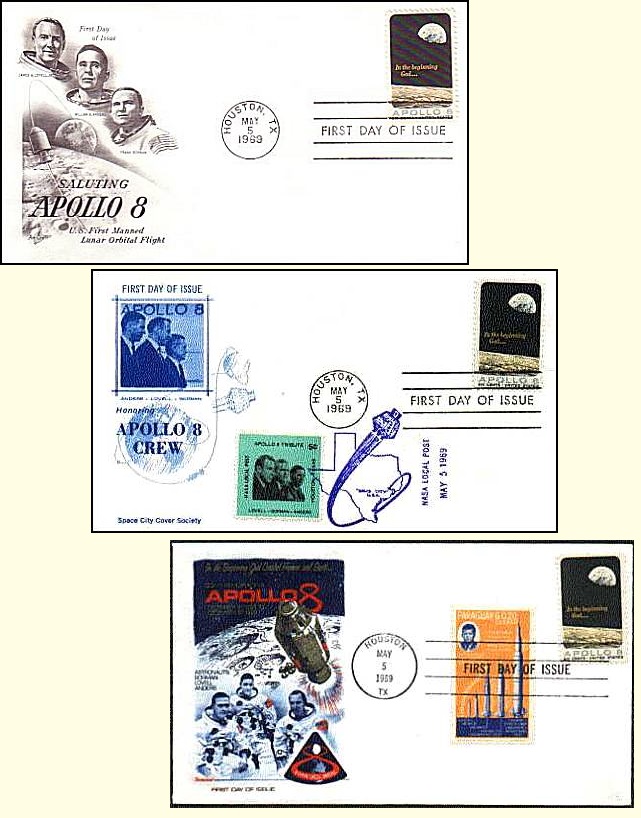
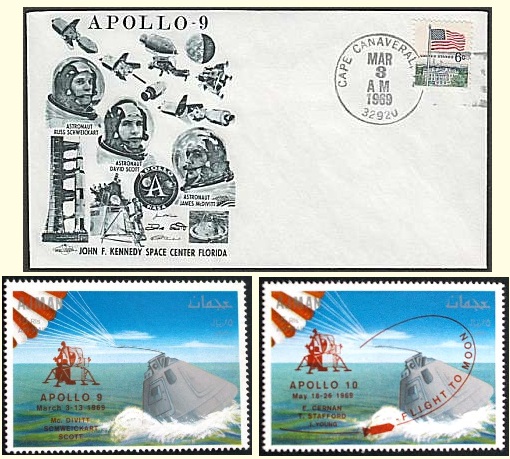
Despite the setback of the Apollo 1 tragedy, Apollo 11 finally succeeded in achieving its goal of a manned lunar landing when astronauts Neil Armstrong and Edwin "Buzz" Aldrin landed their lunar module "Eagle" on 20 July 1969, and walked on the lunar surface, with Armstrong making the now famous statement "That's one small step for man, one giant leap for mankind."
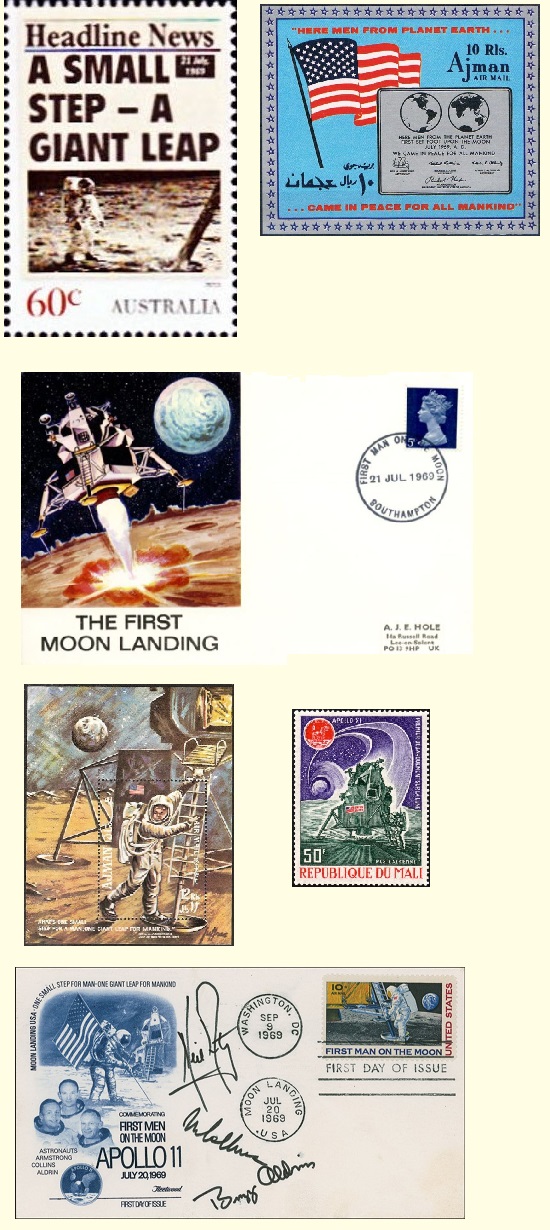
After the first moon landing, there was sufficient flight hardware for nine follow-up missions with an ambitious plan for extended lunar exploration. However, budget cuts and a lack of interest from the American population forced the cancellation of three of these and the programme finished with Apollo 17.
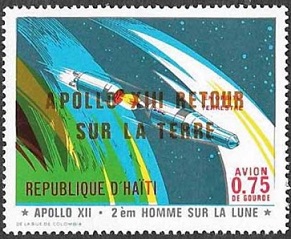
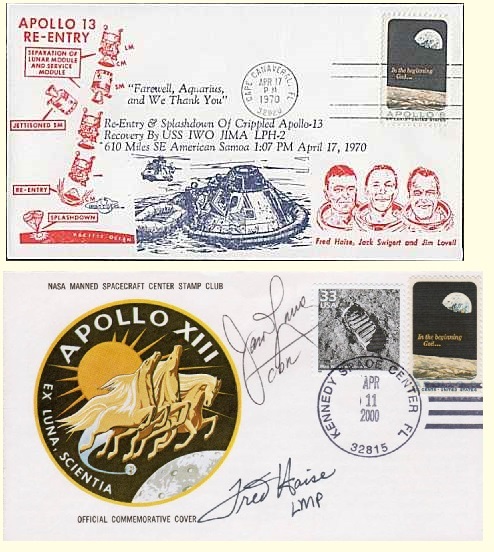
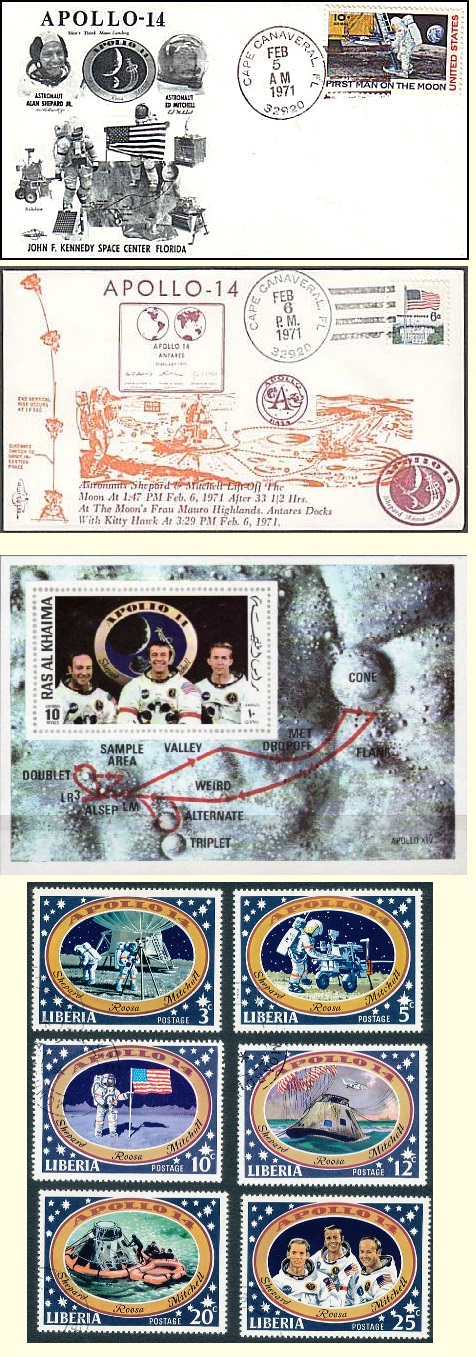
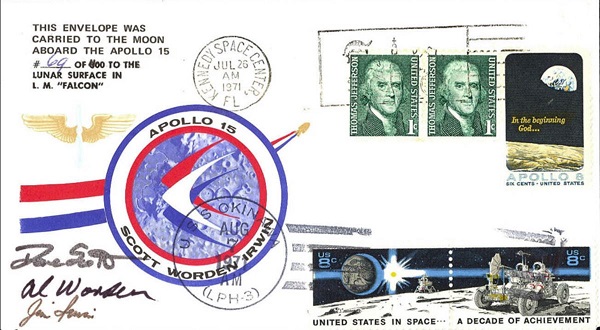
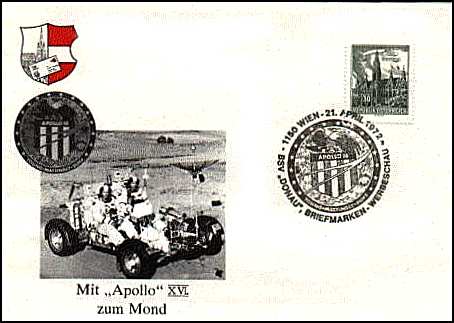
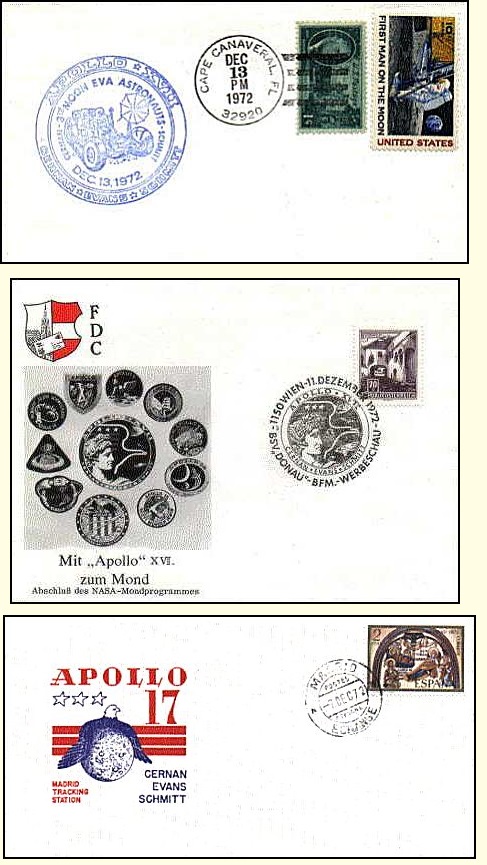
The slide and video presentation was accompanied by 180 well-annotated sheets containing outstanding philatelic material, autographs, photographs, drawings, etc. Many were of world-class quality and rarity. They were from Barry's extensive collection that runs to around 700 sheets, and are a superb collection in their own right, but coupled with the audio visual presentation and delivery from Barry, it was one of the most outstanding philatelic displays we have ever seen. Many members commented on how it was a wonderful evening, and a true delight!
13th February 2018 - Quiz Night
Patrick Reid had set the questions, and Roger Sammons stood in for Patrick to present a quiz for the 3 competing teams, covering history, geography, general knowledge and philatelic matters.
By the half-way point, the team led by Mark had a good lead over their nearest rivals who were led by Richard. Despite the other teams' efforts during the second half, they were not overtaken, and thus Mark, Alastair, Alwyn, Dennis, Derek and Ivan were the deserving winners. Many of the questions really challenged the knowledge and memory of the members, and a good evening's entertainment was enjoyed by all. Chairman Mark Bailey thanked Roger and presented prizes to the members of the winning team.
23rd January 2018 - Members' Acquistions in 2017
Many of our members brought along items they had acquired in the preceding year.
Patrick Reid went first, showing some ephemera from Stamp Exhibitions, a range of (Australian) Postage Due covers and some Tasmanian covers with Postage Paid postmarks of several different types.
Chris Rayner followed with the Isle of Man Commemorative issues for 2017.
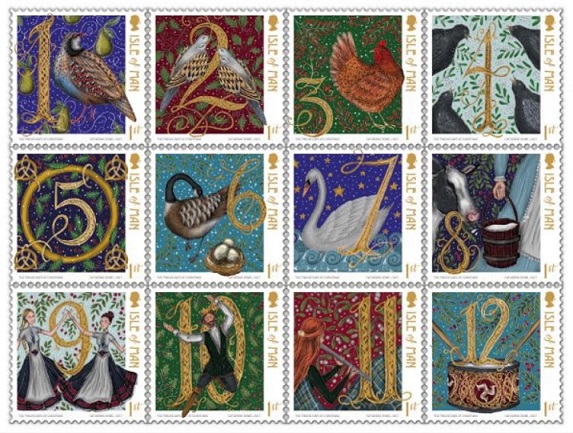
For a change, David Gerken did not show anything relating to bridges! Instead, he began with covers relating to the S23 Flying boat, including a crash cover and Irish experimental airmails. He followed these with King George V Silver Jubilee stamps, including on cover, and then some Southern Rhodesia proofs from the Waterlow archive. David ended his display with a printed World Cup cover and a GPO miniature sheet of 1st class stamps.
15 November 1930 was the 10th Anniversary of the establishment of the Freistadt Danzig. To celebrate this event, the series of 11 definitive postage stamps were overprinted "1920 / 15. November / 1930", and Dennis Proctor showed a set of these.
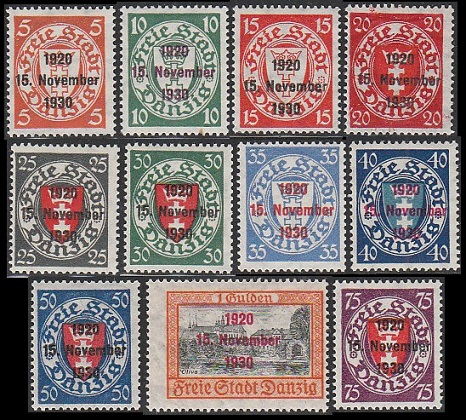
Michael Curling displayed an interesting range of ephemera, cards and covers. These included a newspaper sent through the post, correctly prepaid, prints of the church and castle at Walmer, and an 1873 GPO notice about insecure covers for mail. These were followed by an invitation to, and ticket for, King George IV's Coronation Dinner. Next came a 1d red cover, a Waterlow bill, an 1834 letter rated 4s 11d, a 1688 London Gazette and a photograph of King Edward VII at Sandhurst. Finally, Michael showed an express letter to Frankfurt with perfins, an unclaimed King Edward VIII letter, two postcards of flowers, a 1937 Neopost specimen, a hand-illustrated postcard and an embroidered blotting case containing a wedding certificate.
Mark Bailey brought the first part to a close with modern postcards from The Vyne (National Trust), and a set of the limited edition Benham covers marking the 350th Anniversary of the First Postmark, with the Generic Sheet issued on 15 September 2011, named after Henry Bishop who was Postmaster General when the first postmark was introduced. The sheet and the covers feature twenty 1st class "seal" stamps from the Business and Consumer Smilers set issued in 2010.
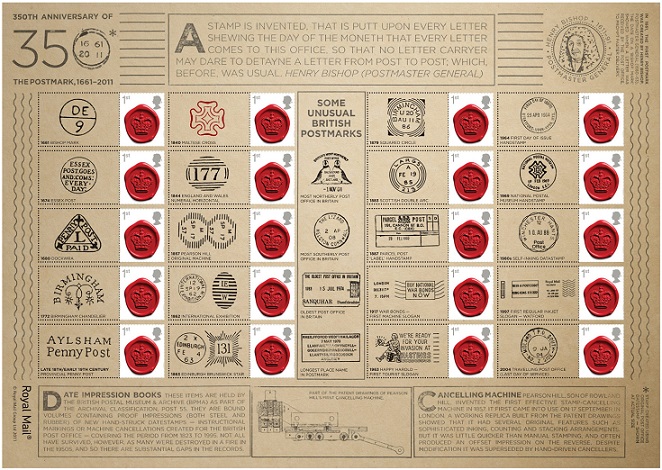
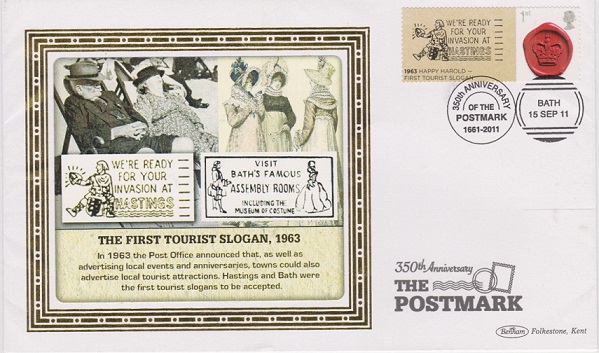
Derek Steele began part two by showing a range of Great Britain shades and a King George V stamp without the cross on the crown. These were followed by material showing the ½d wheel tax, including Carlisle marks with damaged or missing bars and a Newcastle mark struck in green.
Trevor Cornford's display began with Victoria Falls material, including items relating to the Victoria Falls and Transvaal Power Co. The Victoria Falls Power Company, Limited, generally known as the VFP, was formed at the end of 1906, its main object being "to generate, develop and accumulate electrical power at the Victoria Falls, on the River Zambesi in Rhodesia, the Transvaal Colony and elsewhere". The Victoria Falls Power Co changed its name to the Victoria Falls and Transvaal Power Co in 1909, but was still known as the VFP. These items were followed by stationery from Ceylon. This included a Money Order and Savings Bank cancel on a letter card, a number of special cachets and an item to a Prisoner of War camp. Next was a letter written (and cross-written) to his wife from the sender, Silver Jubilee stamps on commercial covers and HSBC perfins on cover. Trevor followed with postcards from the Nimrod expedition, a 1909 letter from Scott and a Loose Ship Letter from Victoria Land. Trevor ended his display with freebies from chocolate packs, with adverts and pictures, an advert for Expedition stamps and a letter from a purchaser and two New Zealand covers.
Alastair Nixon showed Modern Post Office and Barcode labels. He noted that the external sign indicates the type of Post Office, be it Crown, Main, Local or Outreach. Post Offices provide up to 25 services. An interesting chart showed where Post Offices are located, including one in a Chinese Takeaway at RAF Honington. He noted that 90% of Crown Offices have Post & Go machines. He also showed examples of Horizon labels, including Special Delivery (S at bottom right), and Signed for (with L/1/2 for Large/1st/2nd at bottom right), and he finally noted that stamps were normally only available for the bottom two rates.
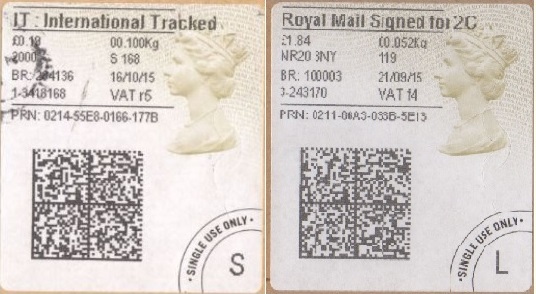
Alwyn Lowe's display of recent acquisitions began with the full range of Swedish stamps for 2017 and then additions to his 1d collection: a Malta block of 6 of 1d on 2½d and a 1d Cape of Good Hope card.
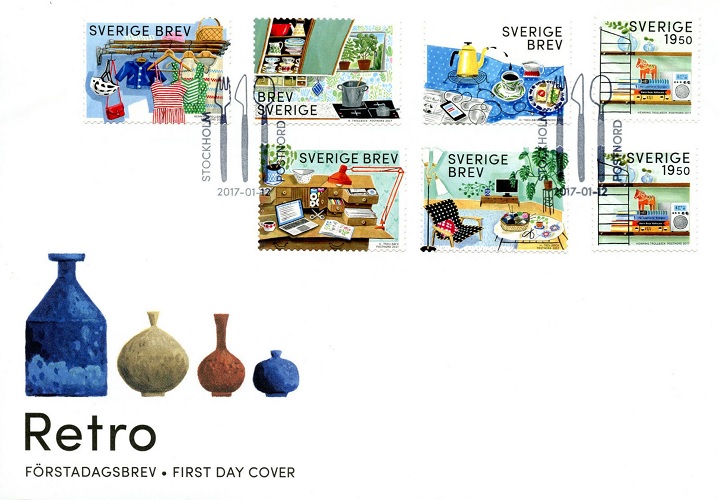
Next, Alwyn showed some Taff Vale Railway covers, including a 2d Railway Letter stamp, and some shades of Queen Victoria 1d stamps. Then there was a collection of covers all to the same addressee, from 1902 onwards. He closed with penny stamps in blocks of four and a range of Esperanto covers and postmarks.
Richard Jenkins brought proceedings to a close with German Stamp Exhibition covers, German Stamp day covers and a range of "Get to know Germany" covers and cards.
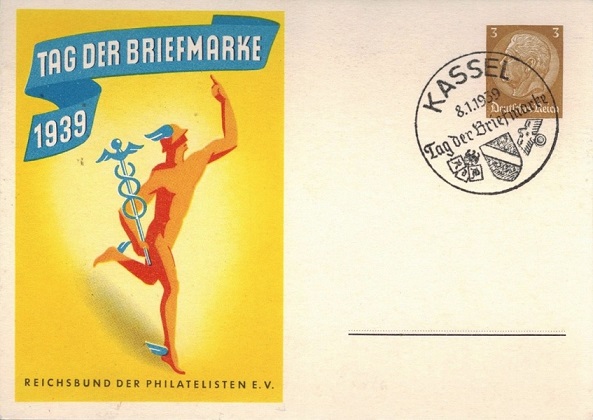
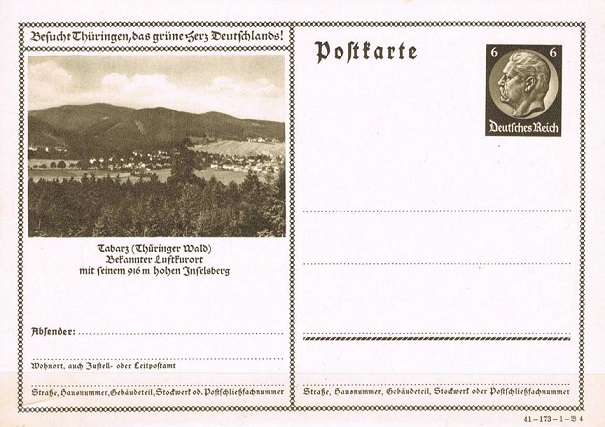
Chairman Mark Bailey thanked all those who had brought material, which once again illustrated the variety of collecting interests in the Society.
9th January 2018 - Chairman's Evening - Mark Bailey FRPSL
Our Chairman, Mark Bailey, entertained us with another comprehensive display. This was on the subject of the Celebration of the Centenary of Postage Stamps 1840-1940.
Mark had brought along a framed example of a Penny Black, and then proceeded to explain in the first half of his display how the Centenary of this stamp was celebrated in Great Britain.
He outlined the planning undertaken by the GPO starting in 1938, and how the plans developed in a series of meetings, including with Sir John Wilson, President of the Royal Philatelic Society London. In May 1938 the Post Office Board endorsed the issue in 1940 of a set of 4 stamps (values ½d, 1d, 1½d and 2½d). December 1938 and the first three months of 1939 involved consultation over the terms of the invitation to artists to submit designs, and the selection of artists. Plans for the issue were announced in the House of Commons by the Postmaster General George Tryon on 27 March 1939; on the following day invitations and accompanying instructions were sent out to 20 artists. Mark's display included illustrations showing some of the stamp designs that were submitted, and also a set of dummy stamps that had been produced featuring a horizontal dual headed design that was submitted by Edmund Dulac in May 1939, but was rejected in January 1940.
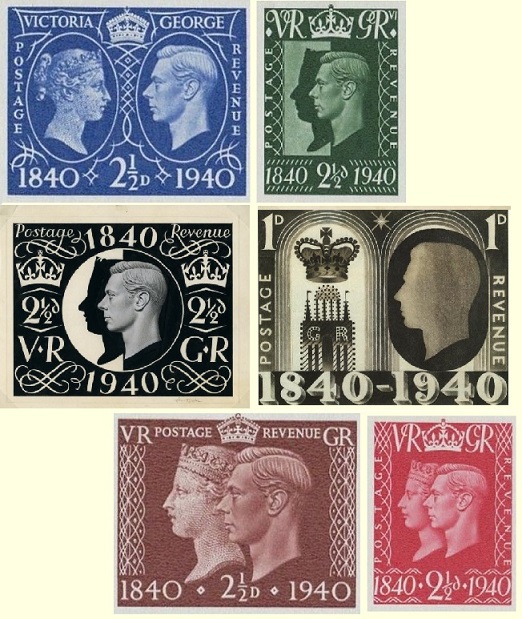
With the outbreak of war in September 1939 the GPO reluctantly abandoned its plans for both the special issue and an intended exhibition, while the Royal Philatelic Society London felt obliged to cancel its own plans for a philatelic exhibition at Earls Court in May 1940. By 21 December 1939, however, the Postmaster General felt that the GPO had gone too far in curtailing all but essential activities, and now doubted the wisdom of abandoning the Centenary issue. Thus it was that the plans were revived, and the design by Harrisons & Sons' staff artist H.L. Palmer was issued as a set of 6 stamps (½d, 1d, 1½d, 2d, 2½d and 3d, but no 1s 3d value for the airmail rate) on 6 May 1940.
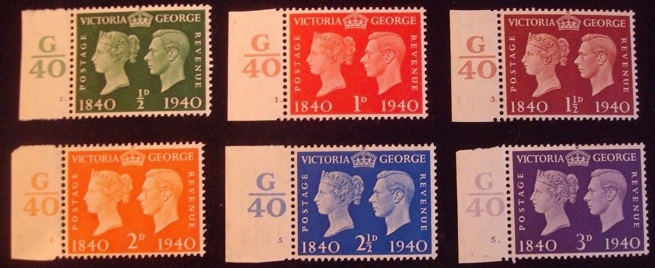
Mark's display showed the set of stamps, including examples of the majority of the cylinder block numbers, first day covers and examples of usage of each of the 6 values. This included the stamps overprinted for use in Tangier and in the Morocco Agencies, and examples of usage of bisected 2d stamps in Guernsey when supplies of 1d stamps ran short during the German occupation of the Channel Islands. He also showed some examples of late usage of a bisected 2d Centenary stamp in Wokingham in 1965 and a 1½d Centenary stamp correctly used as part of a 4d franking in 1953.
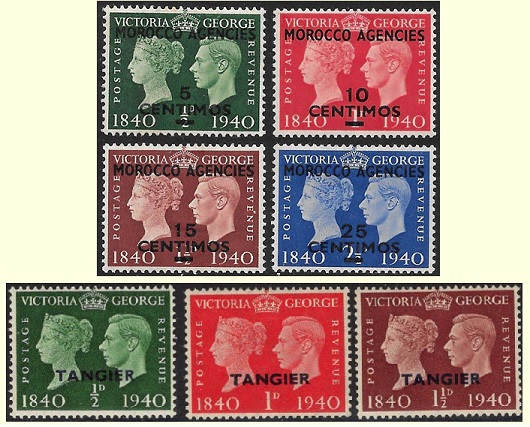
Mark's talk and display covered the celebrations that occurred in Bournemouth and London during 1940 to mark the Centenary. In Bournemouth, the Philatelic Congress of Great Britain took place from 3 to 6 May 1940, immediately followed by the Adhesive Stamp Centenary Exhibition from 6 to 14 May.
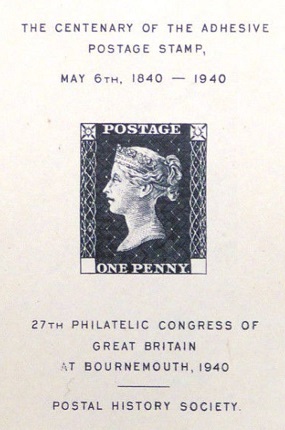
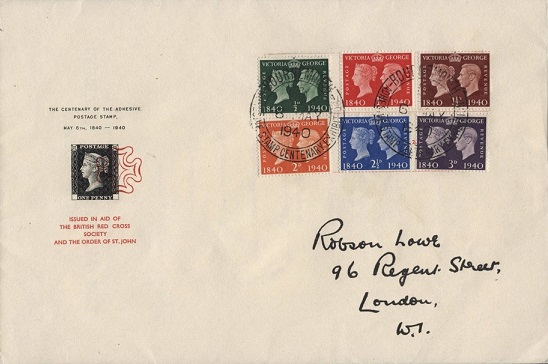
In London, the Royal Philatelic Society London organised a Stamp Centenary (Red Cross) Exhibition held at the London Museum's Lancaster House, also on 6 to 14 May 1940.
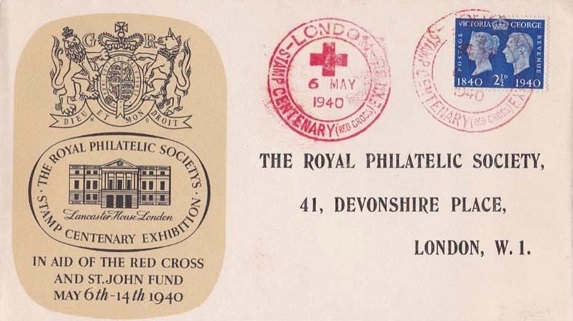
Mark completed the first half of his display with examples of the philatelic souvenirs from these events and a selection of commemorative covers, with the handstamps cancelling the Centenary stamps on most of the dates on which the events took place. Mark also showed copies of the menu and invitations for the celebratory dinner held in London on 6 May 1940, organised by the Royal Philatelic Society London.
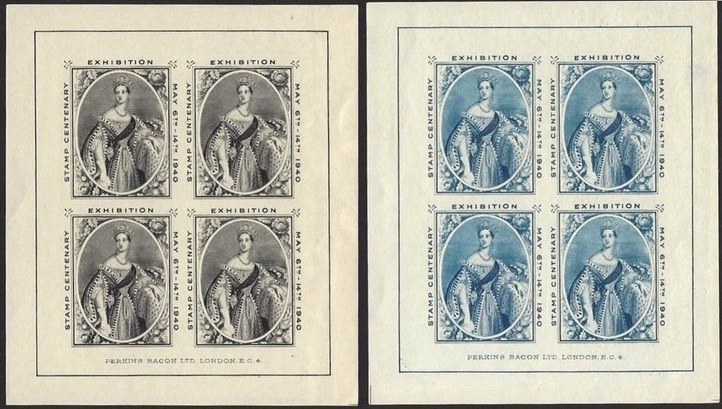
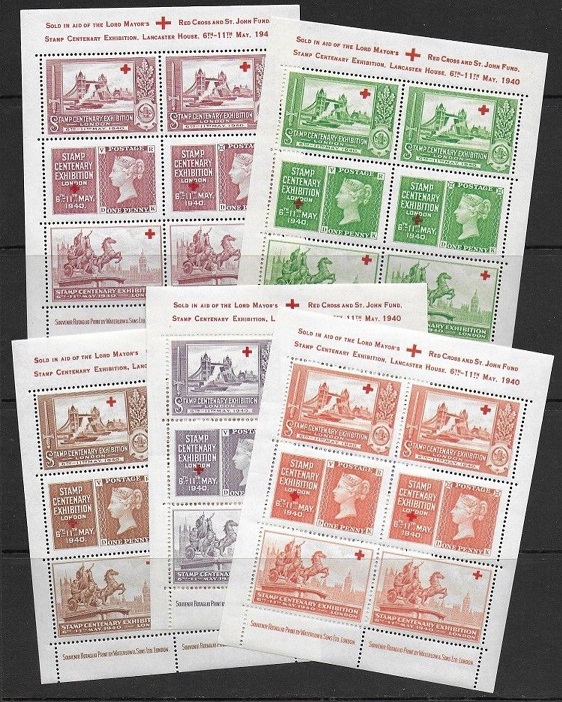
Following the refreshment break, in the second half of the evening, Mark's display covered the way in which the Stamp Centenary was celebrated by countries around the world. Mark explained how in some countries, stamps were issued to mark the occasion, and in others, no stamps were issued, but philatelic organisations produced souvenir labels, sheets, vignettes, cards and covers, and held celebratory exhibitions, dinners, fairs and meetings.

Mark presented material from Argentina, Brazil, Bulgaria, Burma, Canada, Cuba, Czechoslovakia, Denmark, the Dominican Republic, El Salvador, Estonia, France, Germany, Guatemala, Honduras, Hungary, Italy, Liberia, Mexico, the Netherlands, Paraguay, Portugal, Sweden, Switzerland, and Turkey.
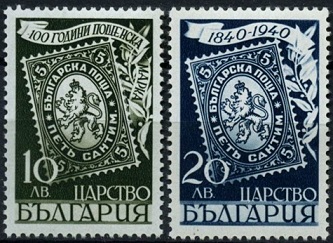
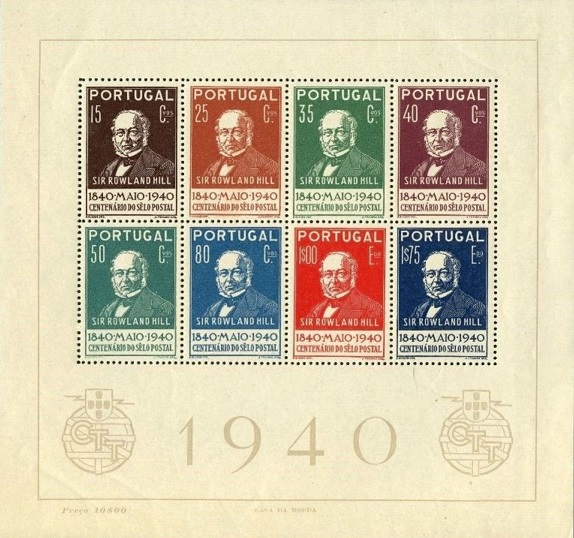
In the final section of Mark's display, he explained that the status of the United States of America in May 1940 was neutral, with public opinion against any involvement in what was seen at the time as a "European" war. There was also a forthcoming Presidential election, and a significantly large German-American vote to be won or lost. The issue of stamps to commemorate a British invention was therefore seen by the politicians of the day to be less than diplomatic. It had been widely anticipated that in the United States a special commemorative stamp would be issued for the postage stamp centenary, and a variety of cachets for first day covers were prepared.
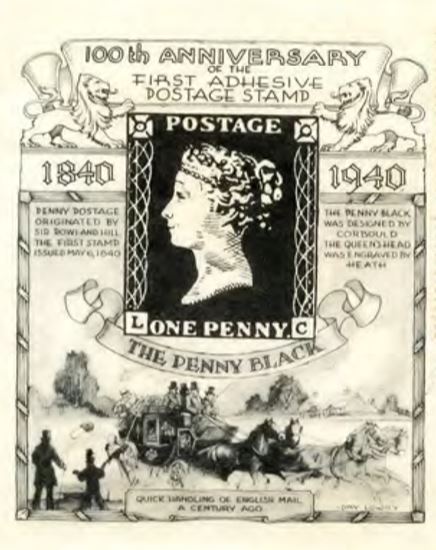
American stamp collectors campaigned for special stamps to honour the Stamp Centenary, but this was vetoed on political grounds, and on 13 April 1940, the United States Postmaster General James Aloysius Farley announced that there would be no commemorative issue for "the British Penny Black Postage Stamp".
Therefore, philatelic organisations across the States called on all stamp clubs to commemorate the centenary in some way. The response to this was overwhelming, with exhibitions and allied events being held all over the United States, where numerous souvenirs were produced. Most philatelic societies issued souvenirs for their festivities and exhibitions, in the main in the form of commemorative sheets and vignettes, and less frequently special covers or cards. Some of the major stamp dealers also issued special Centenary souvenirs, covers and cards. Mark displayed a large selection of these philatelic souvenirs.
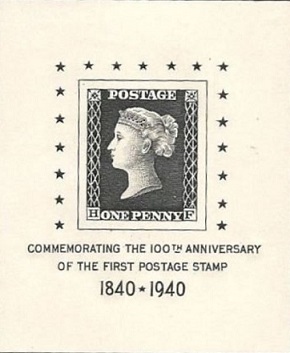
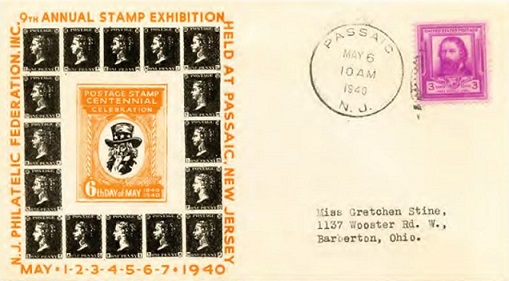
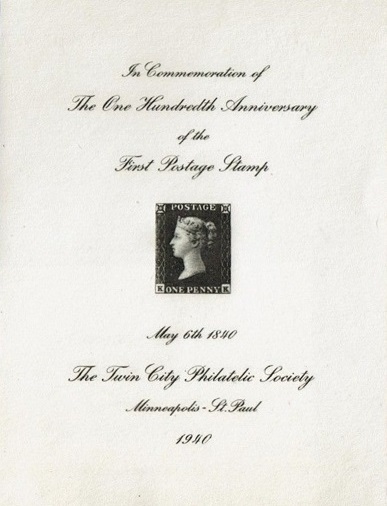
The New York World's Fair that had began in 1939 continued in 1940, and the plans for a stamp exhibition at the British Pavilion at the event were also modified because of the war. Mark showed souvenir covers for the event, some of which included a cachet marking the stamp centenary.
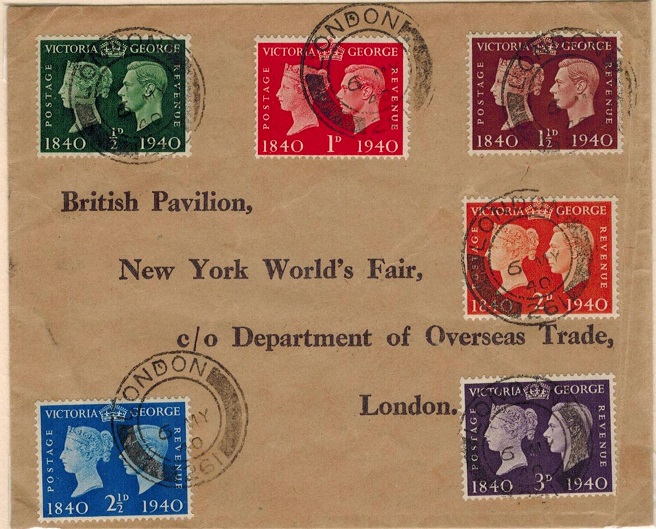
The closest thing to official postal recognition in the United States was a meter stamp produced by Pitney Bowes' newly invented Mailomat self-service machine at the Postage Stamp Centenary exhibition of the Washington Philatelic Society. This was held from 2 to 6 May 1940 at the Hotel Mayflower in Washington, DC. Mark completed his display with a number of items of mail that had been processed using the machine.
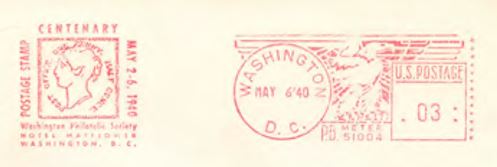
Deputy Chairman Alwyn Lowe thanked Mark for bringing along such well-researched and well-presented material. He said that whilst most of us were well aware that there had been a Centenary in 1940, few of us had probably seen the myriad of items from such a diverse selection of countries.
